
Saturday | January 16, 2021
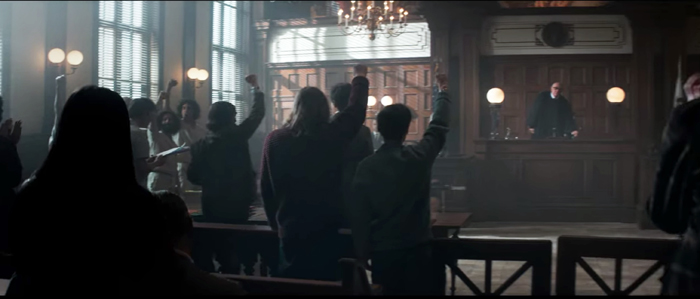
The Trial of the Chicago 7 (2020).
DB here:
Love him or hate him, you have to admit that Aaron Sorkin has carved out a unique position in contemporary Hollywood. If we want to understand craft practice from the position of media poetics—that is, the principles governing form, style, and theme in particular historical circumstances—we can usefully look at him as a powerful example.
He’s more than merely typical, of course. In an era when the f-word exchanges of Palm Springs pass muster as comic dialogue, it’s refreshing to watch a movie where smart characters, sparring for high stakes, make a retort that’s more stinging than a slap in the face. These movies are written through and through, and in distinctive ways.
More broadly, Sorkin’s distinctive career invites us to consider the nature of innovation and originality in the popular arts. Because of “progressive” accounts of art history, we’re inclined to emphasize the shock of the (utterly) new as the mainspring of change and the central source of quality. The history of modern painting is written as a series of breakthroughs after Post-Impressionism, from Cézanne through Picasso and Mondrian and so on—the leap to abandon the past, the “next logical step” in an advance toward…what? Abstract Expressionism? Then what? Similarly, from Wagner to Strauss to Schoebberg to Berg to Webern and then…? Boulez? And…?
If the history of an art is a surging procession of avant-gardes, what then do we do with the artists who don’t fit? There are eccentrics, such as Balthus or Satie, who turn out to “point forward” at angles and detours that the linear-progress story doesn’t allow. What about those artists who refine or revise tradition in fresh ways? Where do we put Deineka, recently noticed as no mere Socialist Realist hack, or Shostakovich and Sibelius? Or, in the orthodox history of the detective story (whodunits surpassed by hardboiled), Rex Stout?
In the popular arts particularly, we should expect to find historical patterns less like the Breakthrough Canon, a high-altitude survey of outsize rock formations, than something closer to the ground. Studying mass entertainments like film and popular fiction, we’re likely to find valleys revealing unexpected views of familiar landscapes. There are daisies in the crevices.
In contrast to the Breakthrough account, non-western art traditions valorize accumulation of options and preservation of precedent. An artist earns acclaim for finding fresh ways to realize long-standing craft principles. The Japanese renga poet, the Chinese painter or calligrapher, and the Ottoman carpet weaver revise inherited techniques to reveal new expressive possibilities. Actually, in the West we have the same situation. Come down from the bird’s-eye view, and we’ll see the same fine-grain fluctuations. E. H. Gombrich pointed out how painters, the masters and the minor players, develop their pictures on the basis of inherited patterns—schemas that they have learned and that provide a point of departure for original treatment.
In several places I’ve proposed that filmmakers work with schemas too—pictorial ones, but also narrative ones. The shot/reverse shot technique is a schema, but so is the framed flashback, the four-part plot, and the strategy of beginning your action at a point of crisis.
You see where I’m going with this. Sorkin is worth studying, I think, as a very skilled craftsman. Surveying just a few of his films showed me that he finds ingenious and sometimes powerful ways to rework the schemas from the tradition of American filmmaking—and, of course, from the theatre.
Ventilating the play
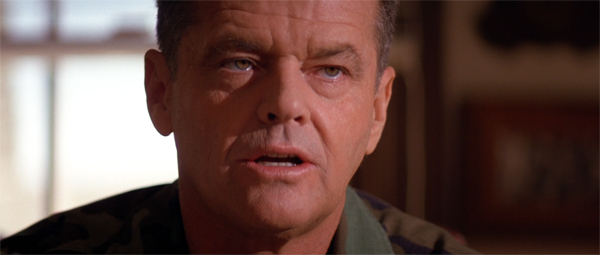
A Few Good Men (1992).
If you want to reach a broad audience in today’s American cinema, you need to either make films with large doses of physical action (as crossover indie directors have found) or to find a signature identity that cultivates a following. In Sorkin’s case, he has dared to rely on plot, dialogue, and a distinct worldview that he has managed to make entertaining. Sorkin’s first plays, followed by the huge stage success of A Few Good Men (1989), typed him as a “theatrical” talent. But over thirty years his film projects sought to “cinematize” what’s usually considered stage technique.
The obvious example is his reliance on “walk and talk,” the long backward tracking shot covering characters striding toward us and spitting out dialogue rapidly. This develops the verbal drama while also yielding some attention-grabbing visuals. But there are less apparent ways Sorkin has blended theatrical technique and cinematic narration.
Early twentieth-century playwrights tended to put the “point of attack”–the moment in the story when you start the play’s plot–fairly close to the climax. Associated with Ibsen and other pioneers of “new theatre,” the late point of attack was a solid convention by the 1910s. As in A Doll’s House and Ghosts, the action starts at a point of crisis, and offstage events leading up to it get revealed through dialogue, sometimes called “continuous exposition.”
The trial schema is a good example of the crisis structure. Typically a trial starts after a lot of stuff has already happened, so the continuous exposition is supplied through testimony and speeches by the defense and prosecution. By 1915, Elmer Rice’s play On Trial was inserting flashbacks that reenacted trial testimony, but some plays stick only to what happens in the courtroom. The Off-Broadway production of A Few Good Men used that linear, present-tense premise, in the vein of earlier plays like The Caine Mutiny Court-Martial (1954) and Inherit the Wind (1955). The investigation of the death of a young Marine is pursued by a prosecution team running up against the military code and a couple of hard-headed officers.
But in preparing the film version, Sorkin adapted to the menu of storytelling options on offer in 1990s moviemaking. For instance, the opening scene could be a grabber, a strong moment that aroused curiosity or suspense. (This might have been a reaction to the need to grab the viewer who’d later see the movie on cable or video.) So instead of letting everything be recounted in the trial, Sorkin’s screenplay for A Few Good Men chose an earlier moment in the story action–a literal “point of attack” showing Dawson and Downey assaulting Santiago.
Later, Sorkin ventilates the play in a traditional manner, supplying scenes that present the prosecutors taking the case and investigating the circumstances. The courtroom scenes don’t begin until about an hour into the film, and they alternate with strategy sessions among the legal team and the defendants. The result is a “moving spotlight” narration, mostly attached to Kaffee the lead prosecutor and Lieutenant Commander Joanne Galloway, but ready to shift to other characters.
The timeline is chronological, except for a brief flashback dramatizing a letter initially voiced by Santiago. He appeals to Colonel Jessep to transfer him out of the unit for medical reasons. In exchange he offers to give information about an illicit fence-line shooting.
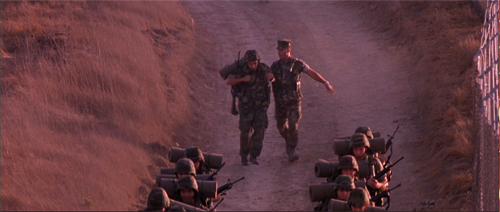
The flashback modulates to Jessep reading the letter aloud (an audio hook) and considering how to handle the situation.
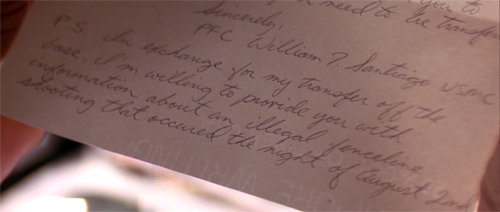 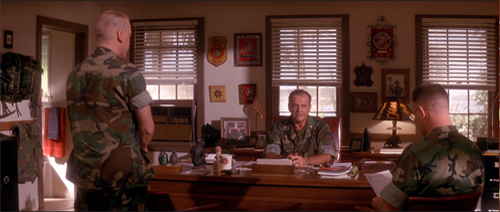
This narration, shifting us from one group of characters to another, gives us a glimpse of the hidden story that the prosecutors need to uncover. The question will become not whether the officers overstepped their authority, but how they will be caught.
After A Few Good Men, we can see Sorkin’s cinematic career as exploring the creative space opened up in the 1990s, a space I’ve tried to map in The Way Hollywood Tells It and several blog entries. For one thing, there’s the matter of how to pick a protagonist.
It seems to me that the film version of A Few Good Men makes Kaffee the protagonist, with Joanne and Sam Weinberg as helpers–just as Jessep is the ultimate antagonist, with Kendrick as his helper. Centering on Kaffee and making him a gifted but glib and cocky young lawyer fits Cruise’s emerging star persona (Top Gun and The Color of Money of 1986, Cocktail of 1988). Sorkin has given us other single-protagonist plots, such as Charlie Wilson’s War (2007), Moneyball (2011), and Steve Jobs (2015).
We may identify Sorkin more with ensemble, or multiple-protagonist, plots because of the fame of his TV shows Sports Night (1998-2000), The West Wing (1999–2006), Studio 60 on the Sunset Strip (2006–2007), and Newsroom (2014-1016). A long-form series permits constant shifting of the protagonist role across a season. But in feature films, I think, a genuine equality among several protagonists is more common in “network narratives” than in crowded films like The Women (1939) and Ocean’s 11 (2001). In the latter, there tends to be a “first among equals”: one or two main characters whose fates are most important, even if subplots centering on others are woven in. Such is the case, I’ll argue, with The Trial of the Chicago 7.
Scanning the menu
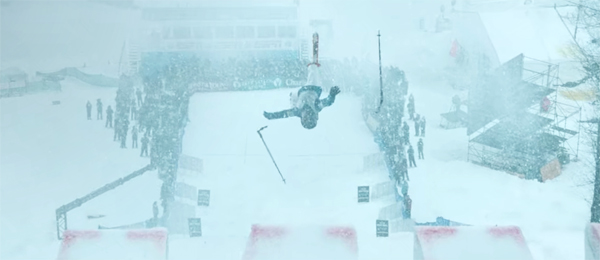
Molly’s Game (2017).
Sorkin’s preferred artistic strategies emerge even more clearly, I think, in his handling of narrative structure. He has more or less systematically surveyed a range of storytelling possibilities.
Politically liberal but narratively conservative, The American President (1995) presents an utterly linear plot. As in other romantic comedies, the central couple shares the protagonist role. Their relationships change as they make decisions and respond to external forces. The film plays out the familiar Hollywood double plotline of love versus work: political pragmatism threatens the President’s affair with a lobbyist for environmental reform. There are no flashbacks or fancy time-juggling, and the dialogue is classic flirtation, wisecrack, and one-upsmanship. The one “Fuck you!” becomes a shocking turning point, a test of friendship.
The crisis structure in The American President is presented as a race against time to line up support for two White House bills. Moneyball (2011) creates a comparable pressure on its protagonist. After his baseball team’s loss and the departure of his top players, Billy Beane faces the need to rebuild his roster for the new season. In a classic problem/solution plot layout, he finds a helper in statistician Peter Brand. Again, the plot is mostly linear, though interspersed with summary montages of sports coverage and brief flashbacks to Billy’s own failed ballplaying career.
The fragmentary flashback that carries its own mystery was a common technique of 1990s cinema (e.g., The Fugitive) and remains a standard tool of filmic storytelling. Sorkin’s films use it often, usually to gradually reveals what’s driving the protagonist’s struggle. A version of “continuous exposition,” the flashback allows deeper character revelation; it can liven up the more static sections of the film; and it can provide its own little mystery revelation. In the Moneyball flashbacks we see Billy recruited, decide to give up a college career, and then face failure. This shows how he could have empathy for the second-tier players who are cast aside–and whom Brand’s moneyball algorithms give a second chance.
The time structure is a little more complicated in Charlie Wilson’s War. Here Sorkin samples another option in the schema menu. The story’s crisis is over; the plot starts at the epilogue. After a credits-sequence montage, we’re taken to a CIA awards ceremony, at which Charlie Wilson is honored for working strenuously against the USSR for thirteen years. This scene turns out to be a frame around an extensive flashback.
What follows deflates this high-flown tribute, as we go back to 1980 and see the reprobate congressman pressured into helping the Afghan people by finagling clandestine US investment in fighting the occupying Soviet troops. Other subplots, including an investigation of Charlie’s partying ways, are interwoven. The long flashback concludes and the film’s final sequence returns to the ceremony, with a replay of a grinning Charlie getting his award. The ABA structure makes the whole public event a charade, underscored by a final title: “And then we fucked up the endgame.”
By contrast, Molly’s Game is more fragmentary. We start with a teenage Molly Bloom in a skiing competition qualifying for the Olympics, but an accident knocks her out of the running. This early passage is in turn interrupted by brief flashbacks to earlier in her childhood, of other competitions and accidents and recoveries, overseen by her demanding father. Her first-person voice-over fills in the background, echoing the fact that the story is drawn from the book she’s written (both in real life and in the film).
“None of this has anything to do with poker,” a title ironically informs us, but it’s a tease. This prologue, mixing scenes from phases of Molly’s girlhood, characterizes her as having tenacity, determination, and not a little rage at her dad. Then the present-day action starts, as usual at a crisis. Molly is wakened from sleep by the FBI arresting her for illegal gambling. What has happened in the meantime? Even after the scene of her arrest, the film’s narration wedges in a VHS interview with young Molly in which she’s asked about her goals.
The revelation of the formative years, saved for late in Moneyball, is put up front in Molly’s Game. But now there’s a mystery: How does a promising athlete become a gambling queen?
The question is answered through another series of time shifts, and these occupy the bulk of the film. After Molly’s arrest, the narration fills in her arrival in Los Angeles and her job working for a sleazy entrepreneur who arranges poker games for rich men. Her rise in the world of underground gambling is intercut with present-time scenes of her consulting an attorney to take her case–a risky proposition, since her customers include Russian mafia. And the alternation of her legal problems and her gambling career continue to be interrupted by flashbacks to her as a little girl, as a teenager, and as witness to her father’s infidelities.
Sorkin has layered his plot within several time zones: present, immediate past, and distant past, with the earliest one including scenes scrambled out of chronological order. Again, the purpose is to reveal character motivation. The flashbacks suggest sources of Molly’s decision to triumph over weak men–perhaps, it’s suggested, as revenge for her father’s mistreatment of her and her mother. The time jumps also reveal her as a fierce competitor unwilling to give in. Athletics, it turns out, has a lot to do with poker.
The network as character prism
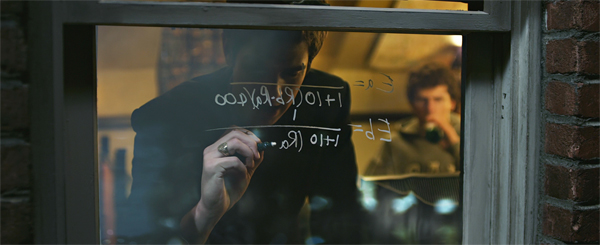
The Social Network (2010).
If there were a simple progress in Sorkin’s exploration of the menu of options, you’d expect that The Social Network would come later than it does. Yet before Molly’s Game yielded three principal time layers (the legal case, the career rise, the girlhood), Sorkin’s screenplay tracing the rise of Facebook had already fielded something more complicated than that.
Still trying variants, Sorkin this time puts the motivating moment, the incident that drives the character, at the front of the film. In 2003, Mark Zuckerberg is on a date with Erica Albright. His arrogance provokes her to break up with him. In a burst of pique, he turns a blog into a page that denounces her and asks readers to rate local women. With the reluctant help of his friend Eduardo Savarin, the site crashes the Harvard server and Mark faces disciplinary action.
At this point the film splits into more time-tracks, again transmitted through legal proceedings. The Harvard disciplinary hearing is filtered through a deposition responding to Eduardo’s lawsuit against Mark, long after their partnership has collapsed. Sorkin could have picked this testimony as his point of attack for opening the film, then flashed back to the origins of the suit. Instead, like Molly’s Game, The Social Network starts its plot in the past, skips ahead to the future, and then fills in more of the past.
A second lawsuit is in progress, this time from the Winklevoss twins, and a second string of deposition scenes. Apparently more or less simultaneous with the Eduardo sessions, these also anchor us in an approximate present and cue up incidents in the past. For instance, in a past scene, after an ally of the twins tells of Mark’s successful webpage, the narration cuts to the opening of the Winklevoss case’s depositions, and then back to the brothers recruiting Mark to work on their project.
The dual-track depositions in the present allow Sorkin not only to segue into illustrative scenes in the past, but also to set up crosstalk between the two lawsuits. Immediately after Mark dodges questions from the Winklevii, we see him dodge questions in Eduardo’s session.
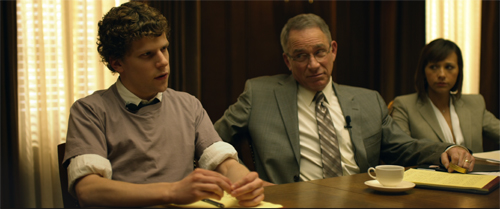 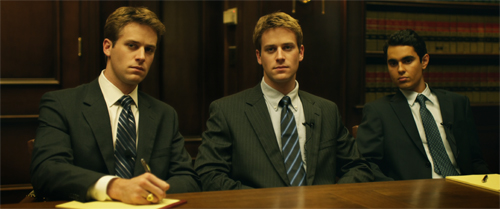
 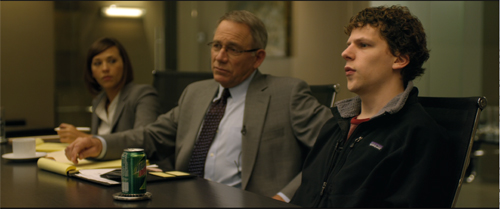
By the 2000s, audiences trained in the time-shifting of the 1990s could follow these quick alternations. It’s also up to the director to keep us oriented through differences in costume, angle, lighting, color design, and other elements.
If you take the opening portion as what sets the narrative Now, you could call the deposition scenes flashforwards. Alternatively, you might consider those scenes as Now, although the opening orientation to them has been deleted. Either way, Sorkin has provided a flexible, dynamic structure that allows us to study Mark’s behavior and others’ responses to it.
One of the dreams of storytellers who embraced multiple-viewpoint plots was the idea of letting us see different, even contradictory facets of a character. The prospect was broached by Henry James (in his novel The Awkward Age) and Joseph Conrad (in Lord Jim, Chance, and other books). On the stage, Sophie Treadwell had experimented with it in The Eye of the Beholder (1919). Herman Mankiewicz and Orson Welles played with the possibility of such a “prismatic” narration in Citizen Kane, perhaps as a result of Mankiewicz’s unproduced play about John Dillinger.
By using the trial schema a storyteller can present a character’s public self-presentation, the impression management that tries to win adherence. But the fact that different people testify about a situation also offers prismatic possibilities. Here, the chief contrast is between Mark’s snotty recalcitrance at the counsel table and his swagger in the past.
During the film’s opening, when Mark confides in Erica and Eduardo, we’re about as close to penetrating his mind as we’ll get in the film. Later the film’s narration offers less a study in how his mind works than a portrait of how he handles people–his social survival strategies. The range runs from sheer bluster, as when he tries to overwhelm Erica, through awkward acceptance of class ambition when he meets the Winkleviii, to evasion, threats, and bumbling efforts at friendship. At the end, he goes flat and legalistic, telling Eduardo: “You signed the papers.” The film’s denouement arrives when Eduardo’s lawsuit is launched. “Lawyer up, asshole.”
The opening sections began in the past, but the ending leaves us hanging in the present. At a pause in Eduardo’s suit, the film concludes on the image of blank-faced Mark staring at his monitor. Isolated by his betrayal of the one person close enough to have been a friend, he’s checking Erica’s Facebook page.
 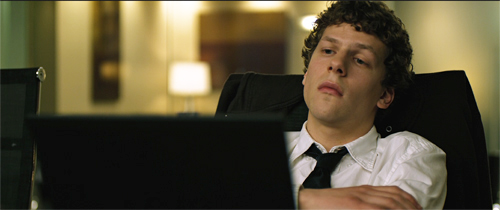
This conclusion lets us imagine that sexual and romantic frustration, exposed in the opening, have reinforced Mark’s low-affect aggressiveness. It’s also a suggestion that his slightly vampirish predation suits him for the age of the social network. But we’ll never be sure, because his disdainful indifference is his armor against everyone he encounters.
As with Molly’s Game, this cluster of parallel timelines is intelligible and forceful as a revision of a schema (present/ past/ present) that we know well. And careful cutting, sound work, and performance have kept us on track throughout.
End to end control

Steve Jobs (2015).
In films that don’t rely on chases, fights, explosions, time travel, fantasy, or extraterrestrials, what can hold your interest? For one thing, snappy talk. The old theatre adage claims that dialogue needs to do one of three things: advance the action, delineate the characters, or add humor. Sorkin’s dialogue does all of them at once.
Steve Jobs is braced by his assistant Joanna while he frets over a press story.
“’The only thing Apple’s providing now is leadership in colors.’”
“Don’t worry about it.”
“What does Bill Gates have against me?”
“I don’t know, you’re both out of your minds. Listen to me–”
“He dropped out of a better school than I dropped out of . . . but he is a tool bag and I’ll tell you why.”
“Make everything all right with Lisa.”
“You know–Joanna–boundaries.”
“You’ve come to my apartment at 1 AM and cleaned it, so tell me where the boundary is.”
“There, let’s say it’s there.”
“If I give you some real projections, will you promise not to repeat them from the stage?”
“What do you mean real projections? What have you been giving me?”
“Conservative projections.”
“Marketing’s been lying to me?”
“We’ve been managing expectations so that you don’t not.”
“What are the real projections?”
“We’re going to sell a million units in the first ninety days. Twenty thousand a month after that.”
Each reply shows that a strong line is like an arrow–feathered at the top, barbed at the tip. If your conflict is psychological, then the last part of the line should land with a punch. “We’ve been managing expectations so you don’t not.”
But the lines don’t exist in isolation. Every stretch of the film is a vivid lesson in whipping together bits of earlier conflicts, jumping from one to another as Jobs parries and ducks and changes the subject, all the while tension rises. One issue is picked up (Steve’s reaction to press coverage), interrupted by others (his rivalry with Gates, his friction with his daughter), followed up by a long-running relation with Joanna (“boundaries”), then a big piece of information: one goal, a sales target set in the first segment, has been achieved. But the others are left dangling, to be revisited, and we are looking forward to that.
This sort of repartee brings back the era of snappy chatter. The exchanges recall the films set in rehearsal halls (Footlight Parade), news offices (His Girl Friday), movie studios (Boy Meets Girl), gangster cafes (All Through the Night), and even a research institute (Ball of Fire). A few films of recent years, such as The Paper, successfully recapture the exhilaration of such fast, pungent dialogue. Sorkin delivers it consistently.
Steve Jobs is one of Sorkin’s most structurally ambitious projects. Here he tries out another menu item, that of block construction. In this layout, we get two or more marked-off chunks or chapters, sometimes without the same characters. Block construction came into fashion with Mystery Train (1989), Slacker (1990), and other indie works, and it remains a basic resource for Tarantino and Wes Anderson.
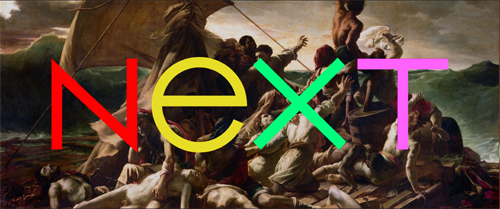
As ever, Sorkin rewrites the block premise as a drama convention, the division into spatially and temporally confined acts. The plot of Steve Jobs is organized around three public product launches: in 1984 (the Macintosh), 1988 (the NeXT Black Cube), and 1998 (the iMac). Each event teems with crises large and small, public and private. They’re all parallel, in that we see the few minutes of preparation leading up to the curtain-raising. Like a party or restaurant scene in a play, a product launch offers a confined space in which characters and story lines can mingle. The pressure of a product demo allows Sorkin to create deadlines and motivate many walk-and-talk passages through backstage corridors.
Just as theatrical is the flow of people into and out of Steve’s presence. From act to act the same associates are ushered into Steve’s presence: his former romantic partner Chrisann, his business partner Steve Wozniak, John Sculley, engineer Andy Hertzfeld, a journalist, and Lisa, the daughter that Steve is reluctant to acknowledge. The French phrase liaison des scènes, “scene linkage,” captures the way that within a single setting characters’ entrances and exits break the act into distinct pieces.
In addition, Sorkin doesn’t confine his time frame to the duration of the demos. As in other films, flashbacks interrupt the present. The 1984 segment uses only one flashback, a visit to garage-hacking days that sets up the dispute about open and close architecture. The flashbacks thicken in the second segment, which reveals the conflict that led Steve to break off with Sculley. That quarrel in the past is tightly crosscut with their confrontation in the present, and as the tension builds one man in the present is replying to an objection in the past. This rapid pacing is one way a “theatrical” premise can hold an audience accustomed to action movies.
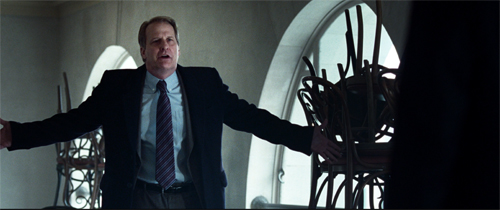 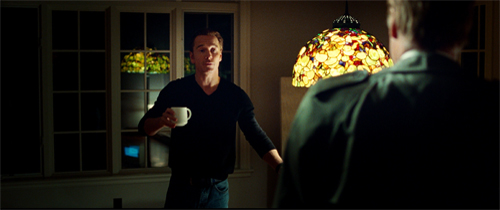
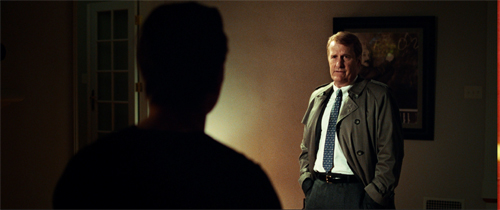 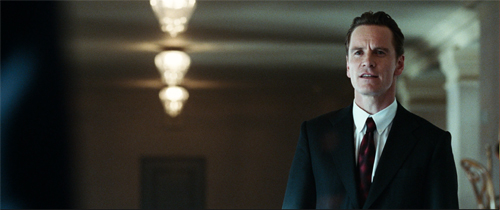
Like Fincher’s intercut depositions in The Social Network, Danny Boyle’s handling keeps us oriented through staging, costume, color, lighting, and shot/ reverse shot eyelines.
The block most saturated with flashbacks is the third, the one launching the computer that brought Apple to marketplace triumph. This chapter incorporates glimpses of scenes shown in the first two segments, along with revelations of Steve’s first approach to Sculley. This last recollection is prompted by his admission that he long ago found the biological father who gave him up for adoption. (Many of Sorkin’s protagonists have Daddy Issues.) Again, a big revelation about character motivation is saved for a flashback late in the film.
In addition, other crises come to a head. Steve appears to break definitively with Wozniak, and he reconciles with Lisa, whom he hasn’t, after all these years, fully taken into his life. As he achieves his goals–a successful computer at last, a settling with Wozniak and Andy, and a tentative accceptance of Lisa–he displays more chastened and cautious behavior. He has admitted his fallibility (he was wrong about the Time cover), he has realized what he lost in challenging and trashing Sculley, and he’s ready to move to the next challenge (“music in your pocket”). True, he treats Woz brutally, but Woz gets the final word: “It’s not binary. You can be gifted and decent at the same time.” Steve doesn’t change completely; he just gets a bit more human.
Interestingly, these cadences fit the four-part structure that Kristin’s Storytelling in the New Hollywood has revealed governing many classical plots: Setup, Complicating Action, Development, and Climax, followed by an epilogue or tag. Sorkin has “cinematized” his three “acts” by letting the final one harbor Development, Climax, and an epilogue.
Kristin also points out that classical film story telling relies on motifs that weave their way through the film. Not only music but lines of dialogue and images recur to point up repeated actions, indicate changes in character, or add humor. (A running gag is a comic motif.) Yet movies didn’t invent this tactic. Novels, poems, and plays rely on recurring motifs. Macbeth circulates imagery of blood and ill-fitting garments, while The Importance of Being Earnest wrings a lot out of the mysterious word “Bunbury.”
Steve Jobs is packed with motifs, far more than most movies I can think of. Some bounce around one segment and into another, and several come back at intervals in all three. All the characters relitigate old complaints, and Steve masterfully deflects a conversation by returning to remarks he’s made before. Here’s a partial list of items that are recycled again and again.
Starting exactly on time, the controversial SuperBowl ad, the need to turn off the Exit signs, a bottle of ’55 Margot, the Time cover, the purported treachery of Dan Kottke, “a million in the first 90 days,” “I don’t have a daughter,” 28%, Woz’s request to acknowledge the Apple II, “playing the orchestra,” closed versus open systems, the name Lisa, “end to end control,” 2001, “a dent in the universe,” slots, Pepsi, the psychology of adopted kids, “You get a pass,” the threat of a press release, and “which Andy?”
For Sorkin, even “Fuck you” becomes a motif rather than a space-filler.
A significant cluster involves the arts, particularly music and painting. In their quarrel the two Steves compare themselves to the Beatles, and Bob Dylan’s image and songs float through the movie. This association with the arts helps offset the unpleasant side of Jobs’ temperament, his crisp, frosty bullying of others and his relentless imposition of his “reality distortion field.”
Another motif softens him a bit: his desire to bring computing to kids. The prologue, in which Arthur C. Clarke is interviewed about the future of computing, sets up several motifs–the idea of separating oneself from others (Steve in a nutshell), the importance of home (associated with Chrisann’s demands), and particularly childhood. The reporter interviewing Clarke has brought his boy along, and they discuss how a new generation will quickly grasp the power of personal computing.
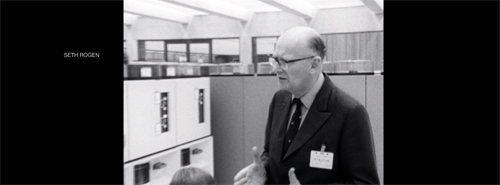 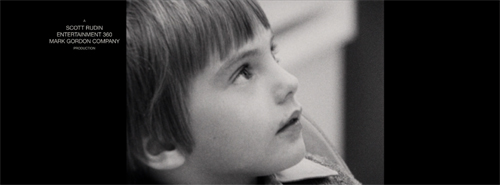
That motif is dramatized when, at first indifferent to five-year-old Lisa, Steve uses her as a demo to show Chrisann what the Mac can do. But his interest rises when Lisa intuitively understands that she can draw with it. “Lisa made a painting on the Mac,” he says thoughtfully. He seems to realize that she could be his brainy daughter, and he resolves to put her in a good school. Her drawing looks forward to Picasso’s swooping dab at a bull in the climactic montage of the 1998 launch.
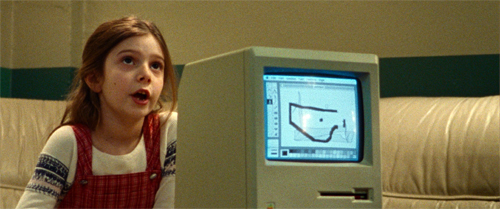 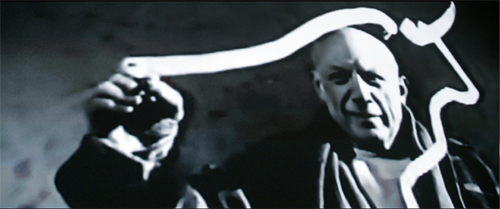
The ping-ponging motifs are mostly in the dialogue, though. They push the action forward, recall earlier moments, and characterize the combatants while also yielding some laughs. Above all, the motifs chart Jobs’ character arc. We know that he’s more committed to Lisa at the end when he breaks his routine and says he’s willing to start the performance late. Soon he will reveal that he has saved her painting to give to her.
In The Way Hollywood Tells It I call Jerry Maguire a “hyperclassical” movie–more classical than it needs to be, flaunting a virtuosity of construction and motivic echo. I vote for Steve Jobs as another instance. Sorkin has used cinema to multiply motifs to a higher power.
Exporting ideas across state lines
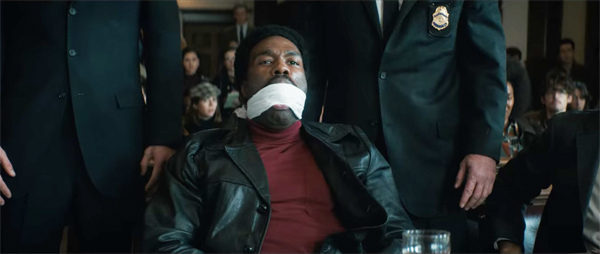
The Trial of the Chicago 7.
One innovation of turn-the-century-theatre was the so-called “drama of ideas” or “problem play.” Ibsen, John Galsworthy, and Bernard Shaw sought to break away from standard intrigues of mystery and romance in order to dramatize women’s rights, labor struggles, and other social issues. Sorkin, with his liberal political bent, has brought that legacy to his film work. The subjects and themes he tackles have become as distinctive a marker of his work as any strategies of form and style.To be more precise, his formal and stylistic strategies work upon the ideas he wants to put forth.
How much private life is a US President entitled to? What is the duty of a politician who wants to enact social change? For a tech entrepreneur, where does idealism end and domination begin? Why should a woman not be able to compete on equal terms with men? Does social change come best through reform (reason, the ballot box) or revolution (change of consciousness)? Something like this last occupies him in The Trial of the Chicago 7.
The problem at the center of the film is: How to protest, and eventually stop, US involvement in the Vietnam war? The film’s prologue and epilogue announce the sweep of the issue. It begins with President Johnson ramping up troop commitments and establishing the draft lottery, all during a wave of assassinations. The film ends with Tom Hayden reading out the names of troops who have died while the trial was dragging on. Early on, Rennie Davis establishes the list because it’s “who this is about.”
The defendants in the trial are only loosely associated. Bobby Seale doesn’t know the others and was in Chicago just four hours; he’s also denied counsel. Sorkin carves out two major factions. Tom Hayden and Rennie Davis, as student activists out of SDS, are presented as preppy intellectuals, committed to antiwar action within the frame of protest and legal debate. Abbie Hoffman and Jerry Rubin, associated with the Yippies, are countercultural provocateurs. They anticipate a spectacle of innocence attacked by those in power. They will show the Chicago Democratic convention to be staged, as Walter Cronkite says at the end of the opening montage, in “a police state.”
Although Tom’s and Abbie’s factions communicate a little before the events, it’s the pressure of circumstances in Grant Park that pushes them into dispute. Alongside them Sorkin develops subplots that suggest other political alignments. David Dellenger’s commitment to nonviolence is tested by the flagrant repression of Bobby Seale. Richard Schultz goes along with orders to prosecute, knowing that the case is trumped up. Jerry Rubin falls briefly in love with an undercover policewoman. Fred Hampton tries to help Seale, only to be killed. Attorney William Kunstler discovers that he has a surprise witness to call. Editor Richard Baumgarten notes that in cutting all these lines of action together: “I feel like one of the great successes of how this film unfolds is that each of the characters does have a moment, or multiple moments.”
Tom and Abbie emerge as the “first among equals” because they most sharply articulate alternative accounts of what they’re facing. They aren’t dual protagonists, like a romantic couple tackling common problems. They’re at odds throughout. On the first day when Tom tries to get agreement on goals, Abbie challenges him.
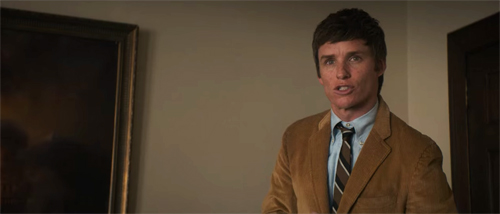 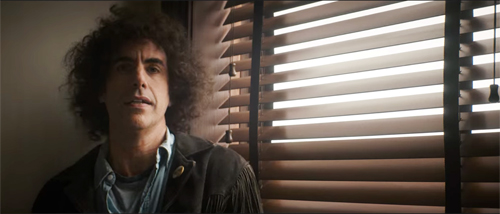
Early court scenes show Tom annoyed by Abbie’s antics, but neither is really an antagonist for the other. Tom can half-humorously admit that he got a haircut to impress the judge, and clearly Abbie admires Tom. The antagonists are the government prosecutors and Judge Hoffman. Tom and Abbie function as what Kristin calls parallel protagonists. Like Mozart and Salieri in Amadeus, or Captain Ramius and Jack Ryan in The Hunt for Red October, they are at once opposed to one another and fascinated by each other. They both compete and cooperate.
What does each one want? This will become part of the drama’s problem, because the two men will be charged with coming to Chicago to stir up violence. Sorkin shrewdly postpones the question in the opening montage that brings some main players together through crosscutting. Incomplete dialogue hooks make their goals somewhat mysterious.
Tom: Young people will go to Chicago to show our solidarity, to show our disgust, but most importantly–
Abbie: –to get laid by someone you just met. . . .We’re going peacefully, but if we’re met there with violence, you better believe we’re gonna meet that violence with–
Dellenger: –non-violence. Always non-violence and that’s without exception. . . . (asking his son what to do in the face of police:)
Dellenger’s son: Very calmly and very politely–
Bobby Seale: –Fuck the motherfuckers up!
Seale’s capper would seem to negate the nonviolence of Dellenger’s position, but at the end of the montage Bobby refuses the pistol his colleague Sandra offers him. “If I knew how to use that, I wouldn’t need to make speeches.”
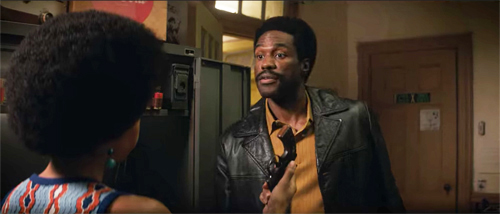
Unlike Dellenger, he’ll hit back if attacked first. So now only the positions of Tom and Abbie remain undefined.
Eventually, Tom exposes his rationale. If they can prove they were peaceful demonstrators within their rights, it will help “to end the war and not fuck around.” That demands treating the trial seriously. “We as a generation are serious people.” And he doesn’t want to raise police culpability. “We’re protesting the war, not the cops.”
From the start Abbie insists that the trial isn’t a matter of law but of contingency. “This is a political trial.” They were chosen to be examples, and the two lesser defendants are “give-backs,” people the jury can let off with a clear conscience. Abbie and Jerry came to Chicago knowing that police violence was very likely. (Cronkite said so too.) The best way to prove state oppression is to lay it bare, preferably with gonzo humor. After all, the whole world is watching.
The film’s structure supports Abbie’s analysis. Sorkin’s narration, using a moving-spotlight approach, has from the start tipped us that Attorney General John Mitchell has ordered Schultz to prosecute the 7 on flimsy grounds. Mitchell, a spiteful conservative, wants to crush antiwar protest, but he’s also petty. He’s miffed that Johnson’s AG Ramsey Clark insulted him on the way out of office. Mitchell has assembled a mixed bag of antiwar activists to charge with conspiracy. (In an ironic twist, they conspire most successfully after they have been thrown together for trial.)
So the problem play becomes a progress toward understanding political power. Tom Hayden (and to a lesser degree Kunstler) come to grasp the reality of an engineered police provocation and a show trial. Abbie’s privileged insight is further stressed by the fact that he’s the only character given a narrator role. Sorkin interrupts the trial with shots of Abbie at a mike in a club, telling the story of the fights during the riots, correcting the false testimony of the cops. In stage tradition, Abbie is the raisonneur, the explainer.
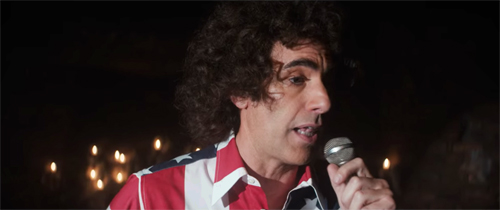
The conflict between Tom and Abbie gets specified gradually, sharpened in strategy sessions where Tom berates the Yippie contingent for clowning. If progressive politics is branded as childishness, “We’ll lose elections.” Abbie calmly replies that “We’re going to jail for who we are.” The debates are about tactics as well. Tom wants the demonstration to keep away from the convention hall, while Abbie insists that they go downtown. As it turns out, the police squeeze them out of the park and force them into a trap that yields the spectacle that Abbie and Jerry anticipated.
Through crosscutting Sorkin again creates several layers of time: the runup to the convention, the protests themselves, the trial, and a more unspecified moment when Abbie is at the microphone narrating. More linear than the time mosaics of Molly’s Game and Steve Jobs, the Chicago 7 array might seem a step back toward the classic trial schema. Basically, the court proceedings frame the flashbacks to the purported crimes.
The relative linearity is needed, however, to allow us to chart the progress of the parallel protagonists. In a neat balancing act, Sorkin dramatizes character change with Tom Hayden and character revelation with Abbie Hoffman.
Hayden’s character arc traces his realization that the trial is rigged. He has brought table manners to a revolution. He presents a wholesome appearance, and when pressed by Bobby he half-admits he’s rebelling against his upbringing. (Daddy Issues again.) Even his “reflex” action of rising when His Honor enters, violating the pact among the 7, shows that the impulse to behave well is struggling against his sincere urge to end the war through citizen action.
Yet Tom has an outlaw side as well. He releases the air from the tire of a cop car to allow Rennie to escape surveillance. At the climax, seeing Rennie beaten, he calls for blood to flow through the city–not, he tries to explain, the blood of others, but the blood freely given by the protesters. Still, he joins forces with Abbie, Jerry, and Dellenger as they are lured onto the footbridge and into the cops’ trap. The cops, having choreographed the street assembly, push them through the tavern window.
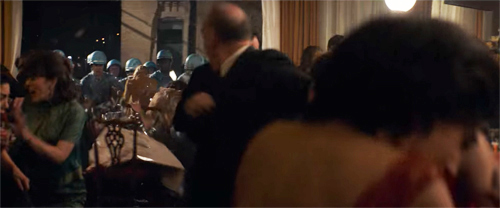
Tom, our main viewpoint vessel in the film, also visits Ramsey Clark with his attorneys. It’s then that he realizes the trial is Mitchell’s political charade aiming to override Clark’s decision not to prosecute the demonstrators. So, after Clark has testified (and sees his testimony suppressed by Judge Hoffman), Tom can redeem himself.
Judge Hoffman has offered Tom clemency before he makes his final statement. The good boy who had asked, “Why antagonize the judge?” rises in polite defiance to read the names of the dead. He will take the same punishment meted out to the others. He now understands revolution as spectacle.
So there’s a little of Abbie in Tom. In the same final stretches of the film, we learn that there’s a little of Tom in Abbie. Tom had planned to testify, but he can’t justify what he said on tape. So Abbie takes the stand. His slapstick persona drops. Behind the Jewish Afro and the wisecracks is revealed an intellectual who can quote the New Testament and gently praise Tom as a patriot. Schultz questions him: Was he hoping for a confrontation with the police? “I’ve never been on trial for my thoughts before.”
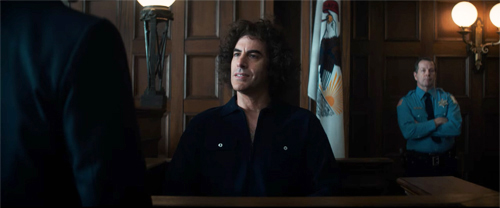
As in the opening montage, Sorkin cuts away before Abbie answers, and his pause and grave demeanor let us consider that for all his bravado, he has regrets about the crisis he saw coming.
Like any problem play, The Trial of the Chicago 7 can be criticized for stacking the deck, or oversimplifying, or recasting the problem in ways that favor certain interests (e.g., white college-educated men). But that critique is the risk artists run all the time, even in the most anodyne “nonpolitical” work. If critics study how films achieve their effects, viewers can be more aware of how the schemas we know are shaped by the movies we see and get a clearer sense of means and ends, purposes and fulfillment.
At the same time, artisanal skill in a robust tradition is intrinsically worth analysis. That analysis can reveal new possibilities in what cinema can do. In The Trial of the Chicago 7 Sorkin creates a dramaturgy that embodies ideas in characters’ conflicts, changes, and hidden facets. Once more a theatrical premise has been turned into classically constructed cinema. Sorkin’s work offers one way that this tradition can stay fresh–not through shocking breakthroughs but by highly skilled reworking of schemas accessible to a broad audience. You know, the way theatre used to be.
Thanks to conversations with Kristin and Jeff Smith, who helped me clarify my ideas.
For more background on this sort of narrative analysis, there’s a synoptic blog entry here. This earlier one might also be of use. Rory Kelly offers some nuanced analysis of the Hollywood character arc.
Cinema’s debts to theatre are considered in this entry, and some others in the category Film and other media. On the power of artisanal care, there’s this on Buster Scruggs.
Another entry discusses how actors use their faces in The Social Network.
P. S. 5 March 2021: I’ve just found some interesting remarks from Sorkin about what he calls “the puppy crate”–the need to focus a drama in a confined time and space. The Trial of the Chicago 7 is an obvious example, but so too is Steve Jobs. “I need four walls really badly.”
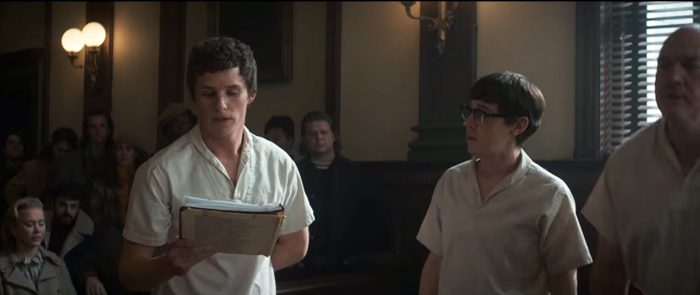
The Trial of the Chicago 7 (2020).
Posted in Directors: Sorkin, Film and other media, Film technique: Screenwriting, Hollywood: Artistic traditions, Narrative strategies, Poetics of cinema |  open printable version
| Comments Off on THE TRIAL OF THE CHICAGO 7: Aaron Sorkin samples the menu open printable version
| Comments Off on THE TRIAL OF THE CHICAGO 7: Aaron Sorkin samples the menu
Monday | December 28, 2020
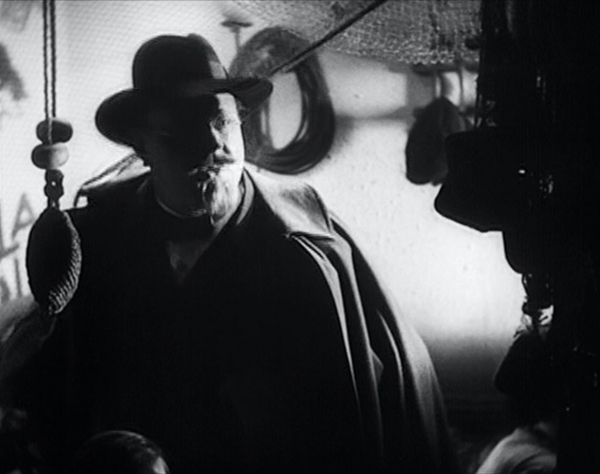
The Blue Angel (1930)
Kristin here:
The end of this horrendous year is fast approaching, though we are still facing a long struggle to end the pandemic. On a happier note, it is also time for a little distraction in the form of my annual year-end round-up of the ten best films of ninety years ago. 1930 was also a grim year, with the Depression well established and nowhere close to its end. Herbert Hoover decided not to use federal governmental powers to help end the crisis (sound familiar?) and eventually was cashiered into a 32-year retirement, though he continued to oppose Roosevelt’s policies. At least we don’t face that long a stretch of down time with the current “president.”
I discovered that 1930 did not produce many masterpieces. There are some obvious titles on my final list, as always, but some of the films are good but not great. In any other year they would not have made the cut. (The contrast with 1927, for example, is pretty stark.) Presumably one major reason is that filmmakers were still struggling with the introduction of sound. Fritz Lang didn’t release a film that year, though he came roaring back with M in 1931, as assured a treatment of sound cinema as one could find during those early days. (For those of you who subscribe to The Criterion Channel, I contributed a video essay on sound in M to David’s, Jeff Smith’s, and my series, also called “Observations on Film Art.”) Eisenstein was off in Hollywood unsuccessfully trying to make a film for Paramount and about to fall in love with Mexico. With one notable exception, Hollywood’s important auteurs made no films or minor films or films that don’t survive.
This dearth of really great films will be short-lived. From 1932 on, I shall no doubt have the opposite problem. For now, here are my picks. All the films are worth seeing, though good copies or even any copies of some are hard to track down. (The idea that all films are available to stream online is as absurd as when, back in 2007 when I wrote “The Celestial Multiplex.”) Some of my illustrations in this entry are subpar, but 1930 does not seem to be a year that studios and home-video companies are mining for titles to restore. I hope this entry will give them a few ideas.
I try not to include more than one film by the same director in these entries, aiming for variety and coverage. This year’s most prolific great directors were Josef von Sternberg and Yasujiro Ozu, who together could have filled in half the ten slots, but I have stuck to my guideline. (When we reach 1932 and 1933, I may be tempted to make an exception for Ozu.)
Given that sound developed at a different pace in different countries, some of this year’s films are silent.
For previous 90-year-ago lists, see 1917, 1918, 1919, 1920, 1921, 1922, 1923, 1924, 1925, 1926, 1927, 1928 and 1929.
Dovzhenko’s Earth
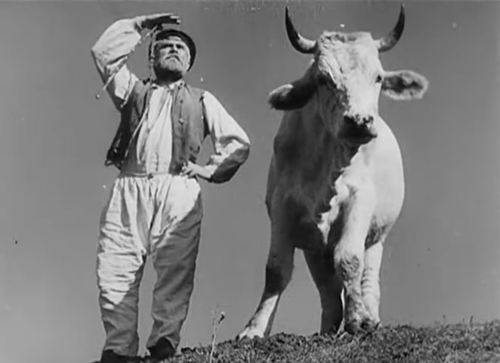
Some of the films on my top-ten list this year may raise eyebrows, but Earth is probably my least controversial choice. It remains one of the last classics of the Soviet Montage movement.
The policy of merging small farms into collective ones had begun in 1927 as part of the First Five-Year Plan. In 1929-30, the push increased, with the seizure of the assets of the more prosperous peasants who resisted collectivization, termed kulaks. Major films were made with the aim of villainizing the kulaks and emphasizing the backbreaking labor involved in traditional, non-mechanized farming. Eager young peasants were hailed as heroes, and tractors appeared as the means to greatly increase wheat yields–wheat which was often seized and sent to the cities to enable rapid industrialization.
Eisenstein had promoted collectivization with his Old and New in 1929, and Dovzhenko followed a year later with Earth. While Eisenstein’s approach had been sarcastic and comic, Dovzhenko pursued his poetic approach to cinema. The opening celebrates the fecundity of the earth and the cycles of nature. The famous opening juxtaposes a peasant girl’s face with a large sunflower. Semion, an aged peasant, is calmly, even cheerfully awaiting his imminent death, lying on a blanket and surrounded by heaps of apples.
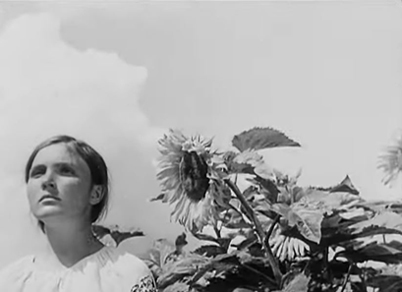 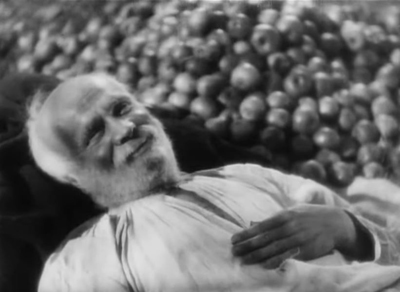
A kulak family is soon introduced, angry at the idea that their possessions will be seized. The head of the family declares that he will kill his animals rather than turn them over, and he tries to attack his horse with an axe.
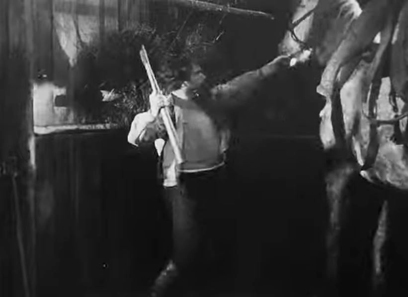
The arrival of the village’s new government-provided tractor marks a shift to an emphasis on the advantages of collective farming. As it approaches, the kulaks stand watching and mocking the idea of a machine taking over. In one shot, an elderly kulak stands framed against the sky, his wealth indicated by the presence of a hefty cow. The tractor temporarily halts, but it turns out that the radiator is dry. The simple solution is for the collective members to urinate into it.
Earth is a visually beautiful film, but like other Soviet classics I have complained about, there is no decent print of it available. The old Kino disc groups it with Pudovkin’s The End of St. Petersburg (the cropping of which I mentiooned in the 1927 entry) and Chess Fever. The copy of Earth is too dark and indistinct. To get some frames for illustrations, I watched the visually superior copy on YouTube, but there the images are cropped to a widescreen format. Just as bad, there are ads scattered through it, including one in the middle of Vasyl’s twilight dance in the road just before he is shot!
As before, I must end by pointing out that an archival restoration and a Blu-ray release are in order.
Ozu debuts on the list
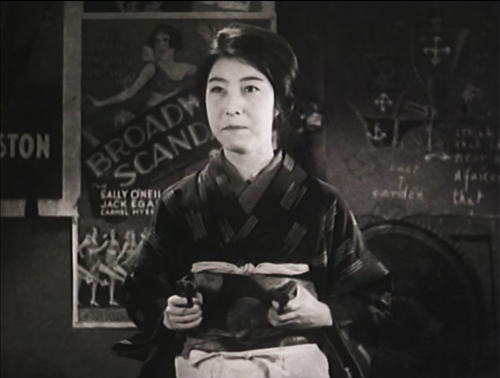
Although after 1937 there are years when Ozu did not make a film, he will likely feature on these lists as long as I continue to post them. In 1930 he made six features and a short. Only three survive: Walk Cheerfully, I Flunked, But … , and That Night’s Wife. I’ve chosen the last, though Walk Cheerfully is a viable candidate as well. Sound was adopted slowly in Japan, and Ozu held out until 1936 before releasing his first talkie, The Only Son, which will doubtless feature on my list for that year.
The British Film Institute released That Night’s Wife in a boxed set called “The Gangster Films,” along with Walk Cheerfully and Dragnet Girl. Yes, Ozu made gangster films, including the wonderful Dragnet Girl, the film that might lead me to make my exception in the 1933 entry.
That Night’s Wife, though, is not really a gangster film. Shuji, the father of a daughter with a potentially fatal illness, is not a gang member but a decent working man who stages a hold-up to get money for her medicine. Ozu handles this hoary plot premise with his usual unconventional approach.
The opening, with its shots of dark, empty streets through which the police chase Shuji, is film noir ahead of its time. We soon are introduced to his worried wife, Mayumi, tending the little girl. She’s cute but has a distinctly bratty streak so common to Ozu children. This and fairly frequent moments of subtle humor help Ozu avoid a purely melodramatic presentation of the situation.
Once Shuji arrives at home, Mayumi gets him to confess what he has done. He intends to turn himself in after the daughter’s crisis passes, but a gruff detective who has posed as a cabby to find out where he lives, appears. Being told that the daughter will only survive if she lasts through the night, the Detective agrees to stay and settles in to guard his prisoner. Mayumi reveals her inner toughness and determination to defend her husband. At one point the Detective dozes off and she steals his gun and points it and her husband’s pistol at him, urging Shuji to escape (above). That shot, by the way, shows a motif typical of early Ozu films: having posters, often for American movies, visible on the walls behind the characters.
That Night’s Wife doesn’t display the fully mature Ozu style, but no one would mistake it for a film by another director. He has already mastered the perfect match on action, and he uses one in the early scene where Mayumi sits down as the doctor tends the daughter. Ozu cuts in with a move across the axis of action that places us 180 degrees on the other side of her.
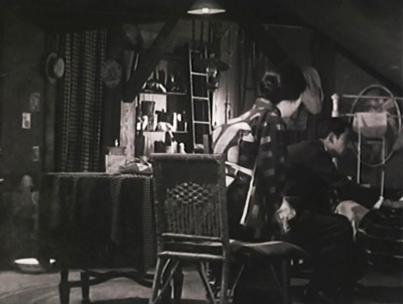 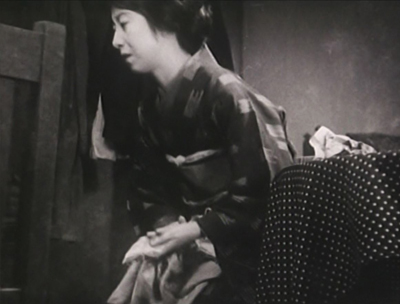
Ozu is not using 360-degree space consistently yet, but he’s playing with the idea. Twice he has transitions that move through a series of adjacent spaces, one of his key devices and one that will last throughout his career. Here we move from the worried Mayumi to Shuji, trying to elude the police after the theft.
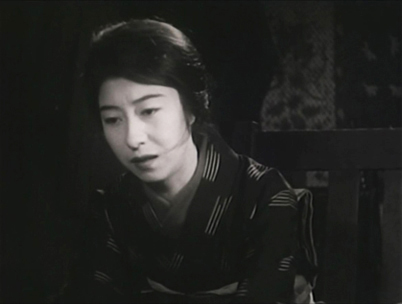 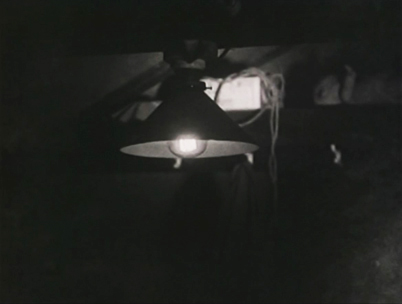
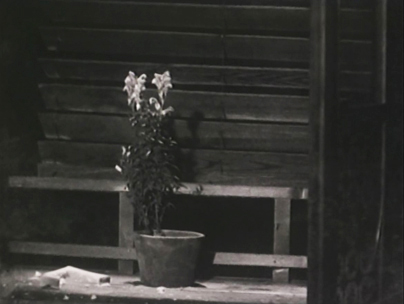 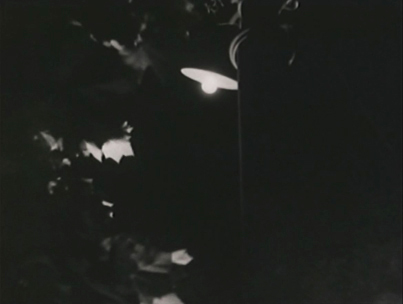
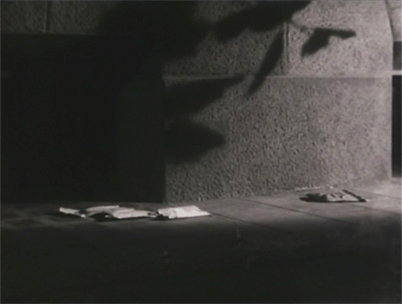 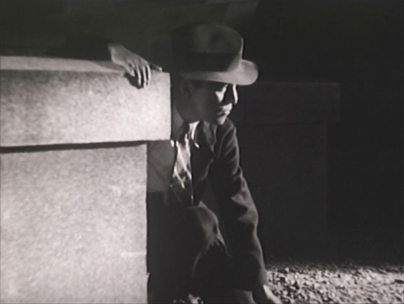
There’s a lyrical motif mutating from shot to shot: worried wife, interior lamp, interior plant against wood, outdoor light with leaves, stone building with the shadows of leaves, and stone building with the subject of Mayumi’s thoughts, cowering. But causally the four “extra” shots tell us little about where Shuji is in relation to the home he seeks to reach.
I took these frames from the BFI set, but in the US Criterion released the same three films in its Eclipse brand under the more accurate title “Silent Ozu – Three Crime Dramas.” (I Flunked, But … is in the BFI’s four-film set, “The Student Comedies.” Criterion hasn’t released a DVD of it, but it is streaming on the Channel.)
The Germans’ sound advantage
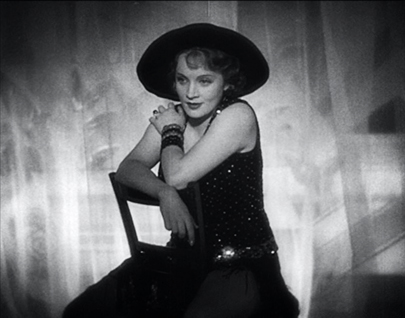
Unlike other countries, Germany developed its own sound system, owned by the Tobis-Klangfilm company. Tobis was initially able to use court injunctions to keep American films out of the German market. In 1930, this pressure led ERPI and RCA, owners of patents on the major US sound-on-film systems, to form a cartel in conjunction with Tobis, which had producing and distribution subsidiaries throughout Europe. Tobis-Klangfilm continued to dominate European sound recording and reproduction until the beginning of World War II.
Partly as a result of this technical advantage, several early 1930s German films became classics, though not all of them are known abroad.
One internationally famous classic is The Blue Angel. I’ve mentioned that von Sternberg was among the most prolific of major directors in 1930. I debated whether to put this or Morocco on the list. If cinematography were the main criterion, Morocco would have been the choice. Not surprisingly, Lee Garmes’s camerawork and lighting is spectacularly good.
I initially saw The Blue Angel decades ago, in grad school. It was the usual hazy 16mm print of the American release version. Watching it again in the German version, remastered from a 35mm negative, was a revelation. Not that it will ever be one of my favorites. It has its problems. The motif of the clown, implied to be Lola’s degraded ex-lover, is heavy-handed. Emil Jannings’ lumbering performance as Prof. Rath is at odds with the casual realism of the other performances. The time-passing montage accomplished via a hair-curler ripping down a series of calendar pages creates a time gap of years passing and the characters–especially Lola–have changed radically. Her change from a kind attitude toward Rath to cruelty and indifference is logical, given his passive decline from professor to clown, but it is presented too abruptly. Still, in my opinion the film’s pluses outweigh its minuses.
The Blue Angel, seen in a good print, is wonderfully photographed as well (see top). It may not have Lee Garmes, but it has Günther Rittau (co-cinematographer with Hans Schneeberger). He had lensed Die Nibelungen, Metropolis, Heimkehr, and Asphalt. He brings a dark look to the film, as in these shots of Rath in dignified professor mode and later onstage in a caricature of his former self.
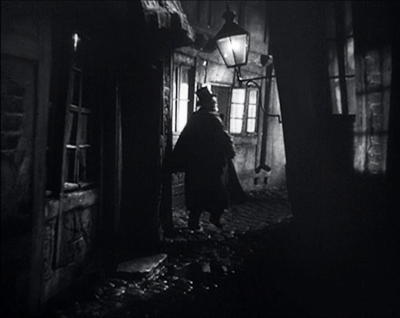 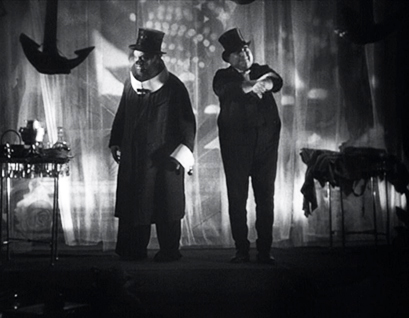
The camera movements are rare and unobtrusive. A visual motif set up early on shows the bustling classroom that Rath presides over, where despite the students’ dislike of him, they obey his strict commands. Later, in after Rath has visited The Blue Angel and met Lola, his blackboard is covered with caricatures and insults drawn there by the students to mock his obsession with Lola. A slow track back emphasizes the empty classroom as he sits at his desk, his authority over the students gone.
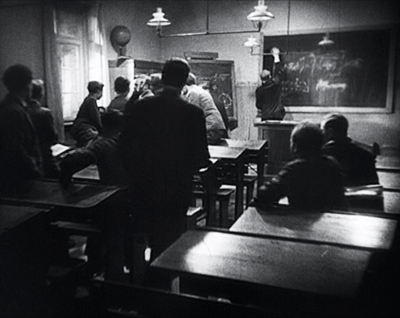 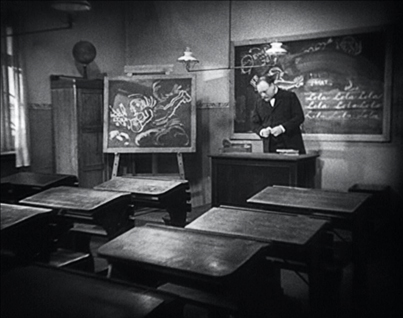 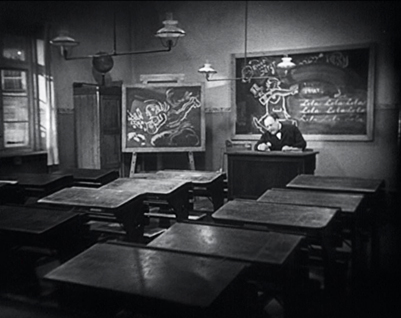
No doubt it’s a matter of taste, but I find Marlene Dietrich’s performance here more attractive than in Morocco–and it is, of course, central to the film’s appeal. Her amused playfulness with Rath, her quietly sarcastic attitude toward her sexuality being The Blue Angel’s main attraction, and her frequent bits of business with props unrelated to the story all differ considerably from her Hollywood performances. She has a natural glamor here that will disappear in her roles for von Sternberg in Hollywood.
After this film, von Sternberg made Dietrich a Hollywood symbol of glamor, but as a result she tends to be less spontaneous and active, with the camera and lighting lingering over her. Basically her glamor became more sultry. The result has its own appeal (and Shanghai Express is a good bet for a place on the 1932 list), but it is revealing to see her performing in a way that she only recaptured occasionally, if at all, in her subsequent films.
The frames were taken from the Kino on Video two-disc set, which has both the German and truncated American versions, as well as some supplements. It was subsequently released on Blu-ray, but I haven’t seen that version.
I always try to call attention to little-known films rather than sticking to the conventional classics for the whole list–and there aren’t a lot of such classics this year anyway. This time it’s a charming, imaginative musical romance, Die Drei von der Tankstelle, or “The Three from the Filling Station,” directed by Wilhelm Thiele and starring Lilian Harvey and Willy Fritsch. It was so popular that it outgrossed The Blue Angel in Germany.
Three carefree young men, who start off driving in a car and singing about friendship, arrive in their lavish shared home to discover that they are bankrupt. Low on gas, they are inspired to start their own filling station. They sing a nonsense song, “Kuckuck” (the German equivalent of “cuckoo”) as their belongings are hauled away, and they give this name to their art-deco filling station.
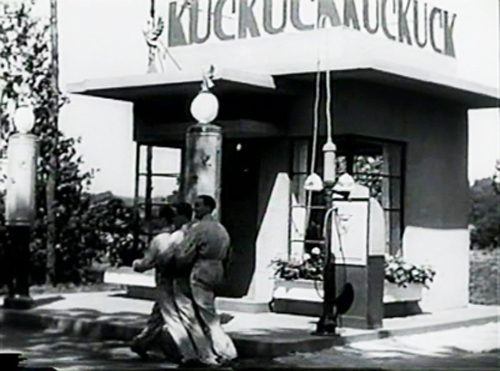
Lilian (the heroine’s name as well) shows up in search of gas for her roadster, and the three men fall in love with her. The rest of the film involves their competition over her. Naturally she chooses Willy (Fritsch’s character name). The two were often paired in later German films of the 1930s and became the ideal movie couple.
The film maintains its playful, often silly tone until the end. As Lilian and Willy are united before a closed theatrical curtain, she turns front and says, “People! The public!” There is an objection that this is not the way to end an operetta and the curtain opens to reveal the entire cast as well as additional dancers and singers performing a lively and somewhat chaotic grand-finale number.
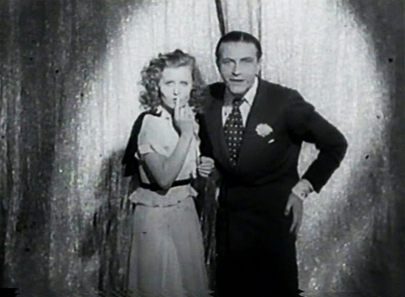 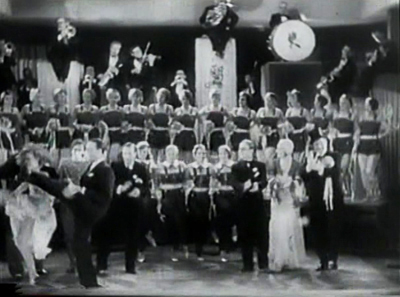
I originally saw this film at the Cinémathèque Royale de Belgique (now the Cinematek). As it does not circulate in the US on home-video, I have taken these low-quality frames from a homemade DVD, probably originally dubbed from an unsubtitled German VHS copy. It is available on a German DVD, since it is considered a perennial classic there. Unfortunately it has no subtitles. (The German manufacturers do not seem to have cottoned onto what their counterparts in other European nations–notably France–have: that if you include optional English subtitles, you can sell more copies.)
I hope, however, that eventually someone at the DVD/Blu-ray companies will discover this very entertaining film and make it more widely available.
A German director abroad
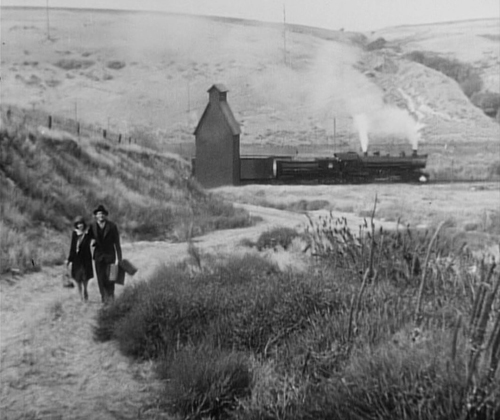
F. W. Murnau’s City Girl is another of those films I saw in a poor print decades ago and respect a great deal more after seeing it in a good version and knowing more about film than I did then. I wouldn’t put it in the same league as some of his earlier films, but for a 1930 list, it stands out.
Murnau was already on the way out at Fox when he was making the film. After his departure, the film was “finished,” including some dialogue scenes that were inserted. As with several other films of the era, such as Borzage’s Lucky Star and Duvivier’s Au Bonheur des Dames (see below), we are lucky in that only the silent version survives. The restored dialogue scenes in Fejos’s Lonesome show how ghastly these added interludes could be. (My apologies to the restorers. Obviously somebody had to do it.)
The heroine of the title is Kate, a waitress in a busy Chicago diner. Disillusioned by the obnoxious male customers she must cope with and lonely in her sparse apartment (below), she dreams of the apparently peaceful countryside that she sees in pictures. Lem wanders in for a meal, having been sent by his tyrannical father to sell the harvest from their wheat farm in Minnesota. He becomes a regular customer as he stays in Chicago waiting for the price of wheat to rise. His friendly, courteous behavior confirms her idealization of rural life, and they fall in love. Once she arrives at the farm, however, her illusions are shattered by the father’s violent rejection and the loutish behavior of a gang hired to help with the harvest, against neither of whom Lem seems able to defend her.
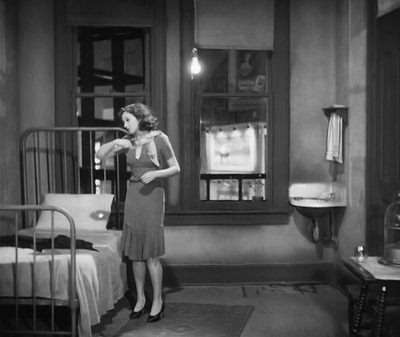
As in Sunrise, City Girl creates a contrast of city and country, though on the whole the city here comes across as more oppressive than the relatively friendly treatment the couple in Sunrise receive there. Sunrise spends half the film presenting the aftermath to the couple’s reconciliation, while City Girl has a grimmer tone, and the happy ending arrives very suddenly and briefly.
According to Janet Bergstrom’s informative essay accompanying the “Murnau, Borzage and Fox” DVD boxed-set, Murnau initially wanted to film in Grandeur, a widescreen format of the day, but the budget wouldn’t allow it. (I suppose the effect might have worked, as the 70mm version of Days of Heaven demonstrates with a similar locale.) Perhaps it was just as well. Cinematographer Ernest Palmer has handled the landscapes well (top of this section) and given a distinctly documentary look to the harvest scenes.
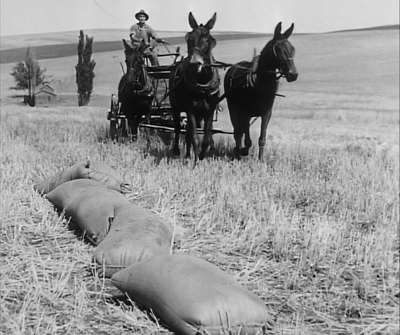
The restored version of the film in the Fox boxed-set is excellent, but that box is long out of print. British company Eureka! has released City Girl on Blu-ray, which should look even better, available as an import on Amazon.com in the US (where it is listed as Blu-ray but is the same edition as is listed on amazon.co.uk as dual-format Blu-ray/DVD).
The French between silence and sound
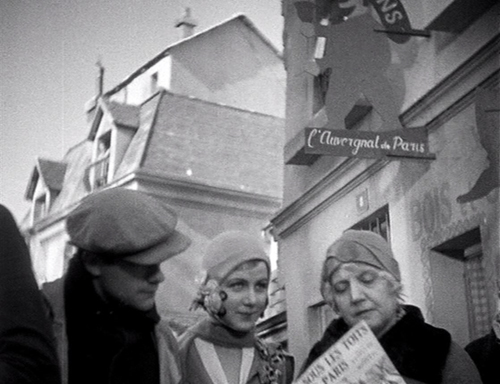
René Clair has long been considered one of the directors whose early sound films were among the most imaginative and technically sophisticated. Indeed, that era was perhaps the high point of his career, with Sous les toits de Paris (1930), Le Million (1931), and À nous la liberté (1932) coming out in quick succession. The first two were made for the French subsidiary of Tobis, Films Sonores Tobis, which produced French films in its Epinay Studios. Its prosperity and technical sophistication are evident in the large sets constructed for Sous les toits.
The film centers on Albert, who makes his living selling sheet music to passersby in the street and leading them in sing-alongs. In the opening scene, a small crowd joins in a song called “Sous les toits de Paris” (above). He falls in love with Pola, who is claimed by Fred, one of the many thugs played by Gaston Modot across his career. She moves in with Albert, but when he is framed for a crime committed by Fred’s gang and sent to jail, she takes up with Albert’s best friend.
This light tale gives Clair the opportunity to show off the flexibility and even flashiness of his style. The opening shot is a long crane movement descending from chimneys against the sky to the crowd singing along with Albert. Clair also uses a variety of camera angles, as in the low-angle still above.
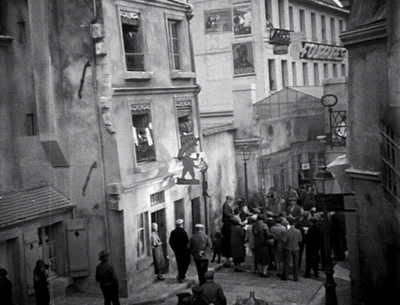
There are several carefully lit street scenes, including this one shot in depth with both characters’ backs to the camera as Albert spots Pola outside a bar.
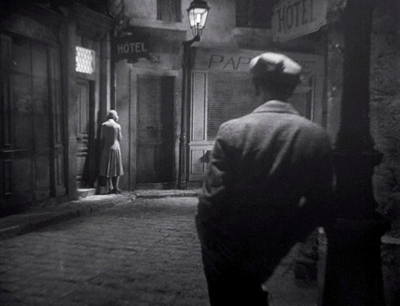
The climactic scene involves a tense conversation between Albert and his pal as Pola looks on. Clair shoots the two men in shot/reverse shot through glass doors, so that we do not hear them but only watch their actions and faces in a deliberate reversion to silent cinema.
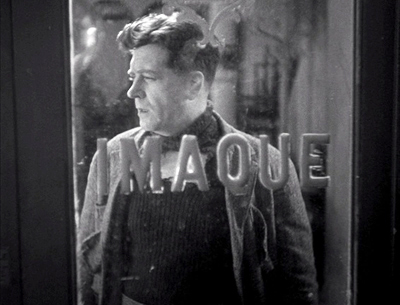 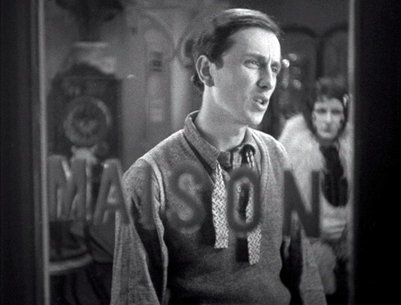
Sous les toits de Paris is still in print as a DVD from The Criterion Collection. (An early issue, number 161.)
At least in the US, Julien Duvivier is not as familiar as Clair, being known mainly for Pépé le Moko, but his reputation is rightly growing. David did his part in promoting Duvivier by contributing a video analysis of his 1941 Hollywood romance Lydia on The Criterion Channel.
I don’t know whether Duvivier was inspired by L’Herbier’s L’Argent (which featured on my 1928 list) to make Au Bonheur des Dames, but there are certainly similarities between them. L’Herbier’s film was adapted from the eighteenth novel in Zola’s Rougon-Macquart series, published in 1891, but the film updated the story to the 1920s. Au Bonheur des Dames was adapted from the eleventh novel in the series (1883) and also updated. L’Argent showed the harm done by large banks, while Au Bonheur des Dames deals with the damage wrought on traditional small shops by the rise of huge, corporate-level department stores. Zola had modeled his giant store on Le Bon Marché, while Duvivier was able to shoot interiors for the store “Au Bonheur des Dames” in the Galerie Lafayette–much as L’Herbier had shot in the Paris Bourse over a weekend.
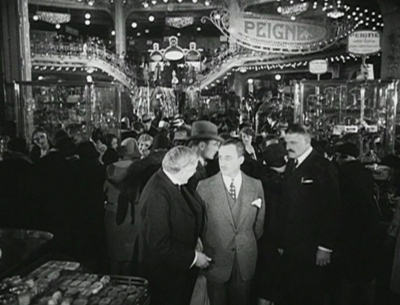
The story concerns Denise (Dita Parlo in her first French film), a naive young woman who comes to Paris expecting to work and live in her uncle’s custom-tailor shop. Instead she finds him on the verge of ruin, since the new department store is located directly across the street. He refuses to sell to Mouret, who runs the department store and wants to expand. But all the shop-owners on the block have given up, and the demolition work removing them gradually drives the tailor mad. In the meantime Denise, fascinated despite herself with the glamor of the department store, gets a job as a model there. She attracts the romantic attention of Mouret and the lecherous attention of a manager and would-be rapist (see respectively in the center and right foreground in the frame above).
Also like L’Argent, Duvivier’s film has strong elements of the Impressionist movement, which was largely over by the late 1920s. The opening portrays Denise’s reaction to the bustle of Paris after she arrives by train by a rapid montage images superimposed around her bewildered face. Later, her uncle’s growing obsession with the demolition of his neighborhood is suggested by many subjective devices, including a prismatic shot of the workers.
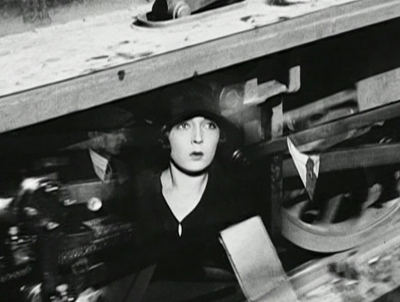 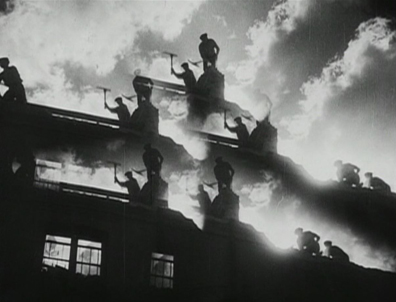
There are also many shots staged in depth, including a cut between Denise’s cousin’s fiancé, who has been caught sneaking out to desert her, and a reverse angle (maintaining screen direction) from behind her as he looks guiltily back.
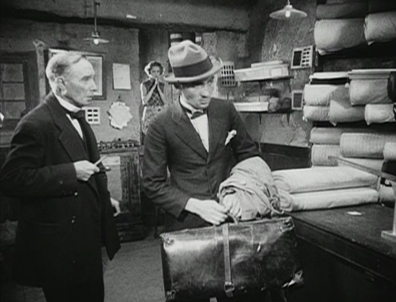 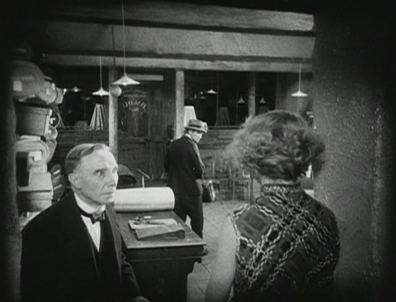
The film was made in both sound and silent versions. Only the latter survives. I watched the Arte Video/Lobster Films version, still in print. (A Facets release in the US is out of print.) The French DVD has English subtitles, as well as a short, informative video introduction by Serge Bromberg in lieu of program notes.
The lingering legacy of World War I
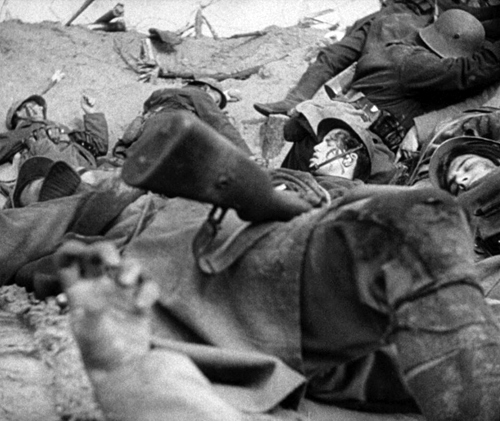
During World War I, the relatively small number of films about the war naturally supported the combat, demonized the enemy, and in the US, urged people to buy War Bonds.
Given the pointlessness and widespread death and injury caused by the war, a reaction soon occurred in filmmaking within the major countries involved. Abel Gance’s J’Accuse (1919) is the earliest film displaying a bitterness about the needless bloodshed of the war, followed soon by Rex Ingram’s adaptation of Vicente Blasco Ibáñez’s 1918 bestseller, The Four Horsemen of the Apocalypse. The film made it onto my 1921 ten-best list. There the emphasis shifts to family members and friends of different nationalities having to fight each other (a theme that Griffith had used in The Birth of a Nation). Four Horsemen ended with progressively distant views revealing an enormous cemetery of white wooden crosses, a motif also used briefly in J’Accuse that would become common in pacifist films of the period.
The next big film was King Vidor’s The Big Parade (see my 1925 list), one of the great box-office successes of the 1920s. The filmmakers went so far as to end the film with the hero reunited with his French love, but having lost a leg in the combat. From that point, killing off some or all of the major characters became the norm of subsequent significant anti-war films. (The Big Parade does kill off the hero’s two friends-in-arms.)
The 1930s carried on the condemnation of World War I, with two of the major films on opposite sides being released in 1930. They carry on the idea introduced in The Big Parade that the ordinary soldiers fighting on the German and American sides were basically alike and could recognize each other’s humanity.
G. W. Pabst’s Westfront 1918 starts late in the war, when the German soldiers in the trenches have become thoroughly disillusioned and unspeakably weary. The first big attack on their position turns out to be friendly fire from their own artillery. (The trope of incompetent commanding officers as among the true villains in World War I–and in some case other wars–has lingered in films ever since.) One of the four German soldiers who form the group protagonist falls in love with a French barmaid in a village near the front. In the final scene, huge numbers of casualties from the latest French attack are treated at a German war hospital, with French and German patients mixed together–as the dead had been in the battle itself (see the image above).
Pabst, like other filmmakers, uses the visit home on leave as a way to emphasize the war’s impact on the home front. Karl, the most important character of the four main soldiers, returns for the first time in eighteen months only to find his wife in bed with another man. Pabst introduces the home-front section with a long line of people waiting to buy food. Karl’s mother sees him arrive but cannot greet him because after hours of waiting she had reached the front of the line.
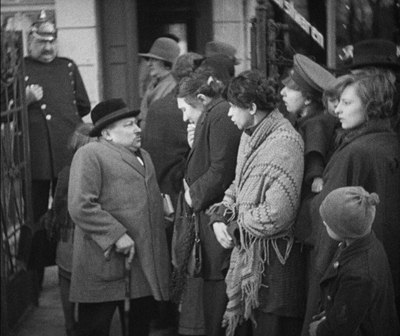
The impressive final battle scene ends with the last of the central characters dead, and the carnage drives the lieutenant who commands them into mad raving.
The film makes a powerful statement designed to end all wars, and yet one cannot help wonder if those Germans inclined to resent the results of the Treaty of Versailles might have been inspired to a greater desire for revenge by it.
The American counterpart of Pabst’s film is Lewis Milestone’s adaptation of All Quiet on the Western Front. The 1929 translation of the German novel had become a huge bestseller in the US. Producer Carl Laemmle, who was born in Germany and visited friends and family there regularly, no doubt had a personal as well as a financial incentive to acquire the rights for Universal.
It would be easy to dismiss this big Hollywood production and ultimate Best Picture winner at the Oscars as a slick commercial venture. Certainly it has the glossy, expensive studio look that Westfront 1918 lacks, as in this scene, with its perfect three-point lighting carefully picking out each figure.
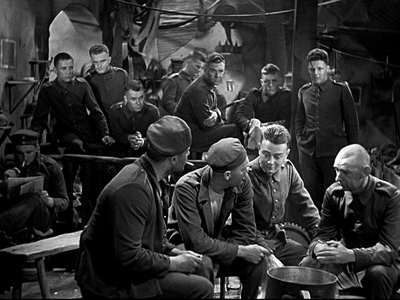
Being from a German novel, however, makes this the first significant Hollywood film to treat German soldiers sympathetically and to make them the lead characters. As in Westfront 1918, there is a tight little group of friends, three in this case, with the point-of-view figure being Paul (Lew Ayres). He is the one whom we follow on his visit home while on leave. There he visits his mother, as expected, but he also drops in on his old classroom and is disgusted to find that his teacher is glorifying war and preparing a new generation of young men to go off to become soldiers.
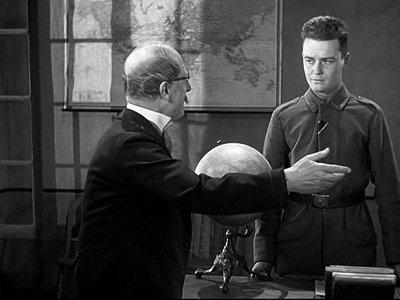
The opening of the film had shown Paul as a student being told of the glories of war and rushing off to sign up. This is the only one of the anti-war films I know of that portrays this sort of social indoctrination as a crucial cause of the horrors of war.
As with the other anti-war films of the 1920s and 1930s, the scenes of are extended and realistic in their depiction of trench warfare. And as in Westfront 1918, all the main characters die. At the end we see them marching off, with vast fields of white crosses superimposed.
The French produced their great anti-war films only slightly behind the Germans and Americans. Raymond Bernard’s masterful but little-known Wooden Crosses (1932), which focuses largely on French troops, is no less powerful in its depiction of trench warfare. Jean Renoir’s Grand Illusion (1938) broke with tradition by downplaying battlefield action and focusing on the senseless loss of life and liberty and the effects of class differences in warfare.
All Quiet on the Western Front has been restored and released on Blu-ray a deluxe edition with DVD and supplements or with the supplements but no DVD.
Experimental cinema in 1930
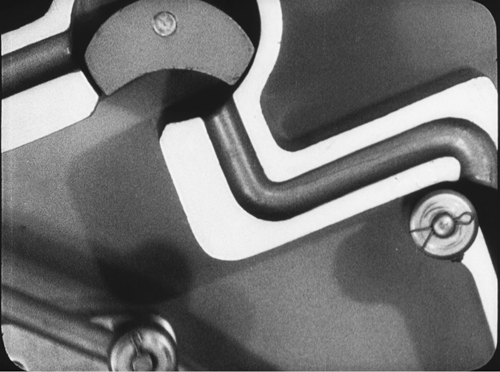
Surprisingly enough, in a weak year for commercial feature films, there was a considerable number of significant experimental films made. The standard historical accounts when I was a grad student (and probably thereafter) suggested that sound made film production too expensive for the shoestring-budgets of experimental filmmakers. Clearly, though, many of them carried on. Some of the 1930 films are silent, but by no means all. Therefore I’ve decided to devote the tenth slot in my list to a brief summary of several of them. These are in no particular order.
Mechanical Principles was Ralph Steiner’s next film after the better-known H2O (1929). Despite the scientific-sounding name, Mechanical Principles is an abstract film made by shooting close view of moving gears and other devices for moving parts of machines (above). The shapes and movements are engaging in themselves, but there is also, I think, a subtle and amusing progression toward more odd and even absurd-looking mechanisms. I doubt anyone would learn anything about “mechanical principles” from the film. (Included in Flicker Alley’s excellent duel Blu-ray/DVD collection, “Masterworks of American Avant-garde Experimental Film 1920-1970.” The visual quality is distinctly better than the versions on YouTube.)
The wonderful German animator Oskar Fischinger specialized in making abstract animation in time to pieces of music. In 1930 he made Studies No. 2 through 7. YouTube contains only snippets of his films; presumably the rights holder, the Center for Visual Music, has diligently patrolled it.) Studies No. 6 and 7 are the most widely seen. I am particularly fond of Study No. 6, to “Los Verderomes fandango,” by Jacinto Guerrero (below). These shorts use a broad range of musical accompaniment. Study No. 7 is done to Brahms’s “Hungarian Dance No. 5.” I haven’t seen all of the Studies, but I assume they all use the same technique, charcoal drawings on paper. There were VHS videotapes released and a laserdisc in 1996, all long out of print. The Center for Visual Music has brought out two DVDs with selections from his films, digitally remastered and with intriguing-sounding supplements.They are sold through the CVM.
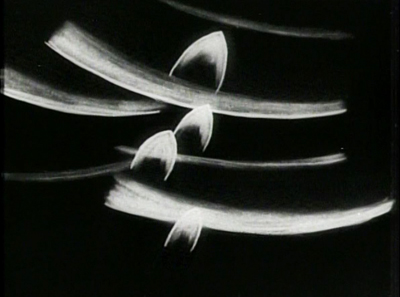
The Bridge is a silent film, adapted from the Ambrose Bierce story “An Occurrence at Owl Creek Bridge.” Its director, Charles Vidor (né Karoly Vidor in Hungary, no relation to King Vidor), had come to the US in 1924 and worked as a chorus singer. He managed to self-finance The Bridge, which centers on a man condemned to execution as a spy. As he is being hanged by a military escort on a bridge, we see a complex combination of flashbacks to his childhood and fantasies of escape (below). The film was impressive enough to gain Vidor to gain an MGM contract to direct The Mask of Fu Manchu (1932). The high points of his long career are Cover Girl (1944) and Gilda (1946).
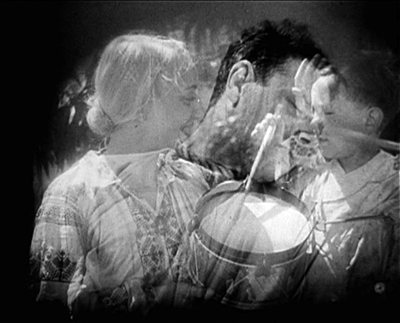
The Bridge is included on the fourth disc in the “Unseen Cinema” collection.
Walther Ruttmann’s Weekend (the original title is in English) is not a exactly a film, even though its subtitle is “Ein Hörfilm von Walter [sic] Ruttmann.” That roughly translates as “a radio-film,” and it was produced by the Reichsrundfunk Gesellschaft (national radio). On the DVD it is reproduced as a black screen with sound over, which one could play in projection. The list of sections given at the beginning runs: “Jazz der Arbeit / Feierabend / Fahrt ins Freie / Pastorale / Wiederbeginn der Arbeit / Jazz der Arbeit” (Jazz of Work / Quitting time / Travel in the Open Air / Pastorale / Recommencing Work / Jazz of Work). The “film” is a lively and often amusing montage of sounds, including trains, tools, engines starting, drum beats, brief snatches of dialogue, a cuckoo clock, a siren, a rooster, and so on. Its twelve-minute length is well gauged to avoid having the device wear out its welcome.
I hardly need to write anything about Dziga Vertov’s Enthusiasm: Symphony of the Donbass. For many years Vertov held his high reputation largely on the basis of Man with a Movie Camera, one of last year’s top ten. Enthusiasm was Vertov’s last Ukrainian film and apparently the first Ukrainian sound feature. Although the film’s credits emphasize that it was shot on location, including the interior of a coal mine, clearly nearly all the footage was shot silent and had a “symphony” of sounds woven together and laid over it.
The film has some of the playfulness and experimental cinematography so familiar from Man with a Movie Camera. That film is so engaging in part because it was primarily a lively look at Soviet everyday life, including movie-going. Enthusiasm, however, is far more overtly propagandistic, being largely a celebration of the early achievement of the First Five Year Plan’s coal quota in the Ukraine in four years. This was thanks to the “enthusiasts,” as the film puts it: Stakhanovites, that is, workers who did considerably more than their comrades through hard labor and efficiency. (They were named after Alexei Stakhanov, a coal miner; the movement started in the coal industry.) Some of the Soviet workers and peasants sincerely approached their work in this way, but in reality much of the achievements of the Plan were achieved through forced labor.
The restored film is included on Flicker Alley’s Blu-ray disc, “Dziga Vertov: The Man with the Movie Camera and Other Newly Restored Works.”
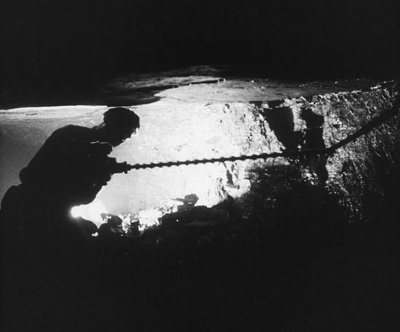
One of the finest experimental films of 1930 is Lázló Moholy-Nagy’s Ein Lichtspiel: Schwartz Weiss Grau (“A light play [i.e., a film]: Black White Gray”). It is derived from his constructive sculpture, Lichtrequisit einer elektrischen Bühne (“Light device for an electric stage”), which consists of many metal elements, some of them pierced with rows of holes, through which lights can be shown to create moving shadows. It later came to be known as the Light-Space Modulator. (The original is in the Busch-Reisinger Museum, Harvard.)
Moholy-Nagy made a film of the Modulator in action, with shifting solid shapes and shadows. It is sometimes hard to tell whether the camera or the device itself itself is moving.
Unfortunately no high-quality print seems to be available. Facets offers several of Moholy-Nagy’s films on separate DVDs, including Ein Lichtspiel–which is a little odd, given that it is only six and a half minutes long. (The modern soundtrack makes the object seem like a very elaborate set of wind chimes.) This DVD is probably the source of some of the better versions of the film posted on YouTube. It would be a pity to encounter the film in this way, but given the current situation, this is the best of the copies available there.
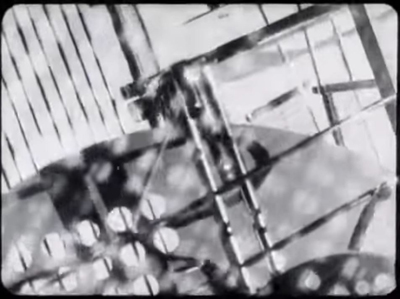
Kenneth MacPherson was co-founder of the Swiss-based Pool-Group, along with his wife, Bryher (née Annie Winifred Ellerman) and the poet, HD (Hilda Doolittle). Together they started Close-up, an important journal on international art and experimental cinema (1927-33). MacPherson made a few films, most notably the short silent feature Borderline. MacPherson was influenced by French Impressionism and Soviet Montage, and their stylistic traits are used in Borderline, including subjective camerawork and bursts of very rapid editing to convey violence or psychological stress.
The plot deals with racial and sexual tensions in a small Swiss village when a black couple comes to live there. Pete, in a genial performance by Paul Robeson, takes back his fiancée (or wife?) after she has had an affair with a white man, Thorne. Thorne remains obsessed with her, which gradually drives his neurotic, racist wife, Astrid (HD, credited as Helga Doorn) mad. Although Thorne has rented a room over a tavern owned by people sympathetic to the black couple, the scandal leads the villages to demand that Thorne be evicted, and he leaves town.
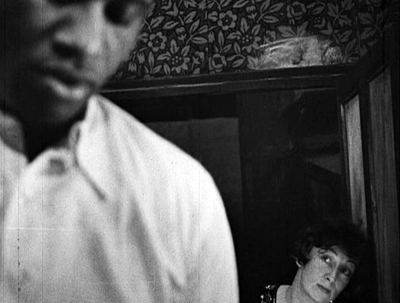
Some other experimental films made in 1930 that I didn’t think were as good as these but are still worth watching if one is particularly interested in this genre:
Francis Bruguière’s Light Rhythms (on the third disc of the Unseen Cinema set), a more low-budget attempt at something like Ein Lichtspiel, using paper cut-outs.
Luis Buñuel’s L’Âge d’or. (The BFI Blu-ray/DVD combo is out of print, although amazon.com is still selling it. Kino Lorber put out a DVD, which I haven’t seen.) I know this is considered a wonderful film by many, but I dislike it and much prefer Un chien andalou.
James Sibley Watson’s Tomatos Another Day (on Kino International’s “Avant-garde 3” set) is a pretty dreadful film, a sort of “theater of the absurd” before its time. I suspect it is a parody of a modernist play of the day. If so, and if anyone knows what play it was, please message me on Facebook and I’ll add that information. Suffice it to say that the husband, his wife, and her lover say obvious things out loud and very slowly “You are my lover,” “I am alone,” that sort of thing. Then all three start talking in dreadful puns (“Tomotos’ another day”). One might say it’s so bad, it’s good.
Sergei Eisenstein and Grigory Alexandrov co-directed Romance sentimentale, a quite uncharacteristic imitation of French Impression or city symphonies. Finally getting a chance to see it decades ago was one of the great disappointments of my life. It is available as a supplement on the Kino DVD of the restored Qué viva México.
A succinct account of Tobis-Klangfilm’s business operations can be found in Douglas Gomery’s “Tri-Ergon, Tobis-Klangfilm, and the Coming of Sound,” Cinema Journal 16, 1 (August 1976): 51-61. (Available on JSTOR.)
I have summarized the “wooden crosses” motif that is almost universal in anti-war films of the 1920s and 1930s (and occasional later films as well) in my video essay on Raymond Bernard’s Wooden Crosses on The Criterion Channel, where the film is permanently streaming.
Our friend and colleague Vance Kepley published an excellent study, In the Service of the State: The Films of Alexander Dovzhenko (University of Wisconsin Press, 1986).
January 27, 2021: Thanks to Cindy Keefer of the Center for Visual Music for kindly sending some corrections to my discussion of Oskar Fischinger:
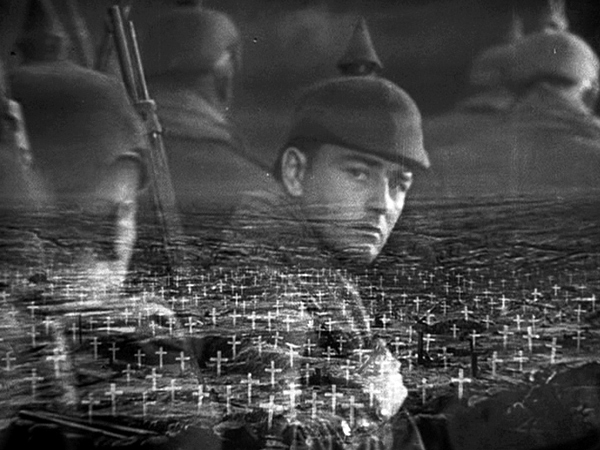
All Quiet on the Western Front (1930)
Posted in Directors: Murnau, Directors: Ozu Yasujiro, Directors: von Sternberg, Experimental film, Film comments, Film technique: Sound, National cinemas: France, National cinemas: Germany, National cinemas: Japan, Silent film |  open printable version
| Comments Off on The ten best films of … 1930 open printable version
| Comments Off on The ten best films of … 1930
Sunday | December 13, 2020
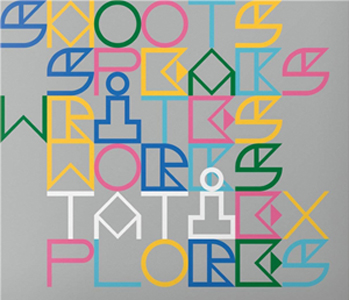 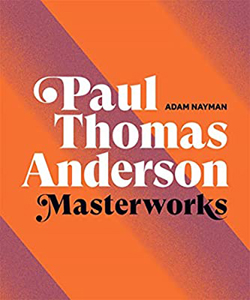 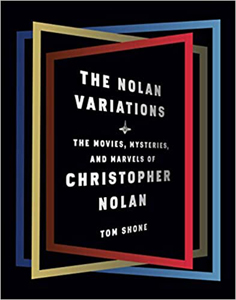
DB here:
The fears that electronic publishing would kill off the physical book have abated. Just as home video and theatrical moviegoing managed to coexist, readers seem to have divided their commitment between e-books, to be read on the go or tapped into for certain purposes (cooking, exercise, reference), and books they want to have and to hold.
Publishers have noticed. They’ve realized that sumptuous books have their own appeal, and art books and de luxe editions continue to be printed. With the rise of digital publishing, one editor notes, “Hardback books have to be more beautiful., better produced, and a pleasure to handle. The market for books worth fondling is bigger and expanding.”
This conviction is affirmed by a trend that I’m sure you’ve noticed. We’ve long had fancy picture books devoted to film; the first one I owned was The Movies, by Arthur Mayer and Richard Griffith, from 1957. The Big Movie Picture Book is a long-lived genre, devoted to personalities, periods, and the making of classics like The Wizard of Oz and Gone with the Wind.
But the trend I have in mind is different. It’s the de luxe book dedicated to a director, with documents capturing the creative process and texts written by serious critics. Call it the Massive Auteur Monograph.
Massive because it’s high, wide, and handsome, as well as heavy. Some of these books are monstrously big, and all boast coated paper and production design suitable for a book on any of the fine arts.
Auteur because it pursues the idea, now commonplace, that the director is the central creative figure in much filmmaking.
Monograph because it’s not just an anthology but rather a through-composed argument about the significance of the auteur in question. Even when the book compiles texts by several hands, those texts form part of a coherent “database” sprawling across the big pages.
In art publishing, books like this are a staple, often attached to particular exhibitions or museum collections. And we’ll see that there are some forerunners of these cinematic “art monographs.” But now I think we’re seeing the MAM come into its own.
Just this year we’ve had three major additions to the stack: the Taschen boxed set devoted to Jacques Tati, Adam Nayman’s book on Paul Thomas Anderson (Abrams), and Tom Shone’s study of Christopher Nolan (Knopf). Each deserves in-depth discussion, but I can’t do justice to that here. This isn’t a review. Instead, these books set me thinking about how we got here, and what “here” looks like. I want to consider how film criticism seems to have been changed by this genre of publication.
Each director gets a book, maybe several
Start with auteurist criticism itself, as practiced in France and Anglophone countries. Let’s distinguish dossiers from critical appreciations.
A dossier collects documents about the director, while a critical monograph offers an ongoing argument. A dossier can spark ideas and introduce you to new information; a critical book focuses on a line of inquiry and marshals evidence around that. A through-composed book is a multi-course meal, while a dossier is a buffet, and sometimes a meal made of appetizers.
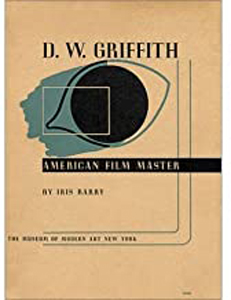 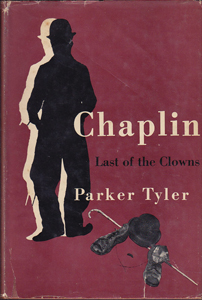 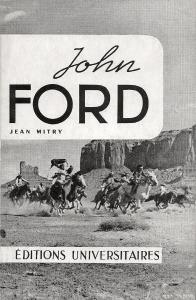
D. W. Griffith: American Film Master, a catalogue of an influential Museum of Modern Art exhibition of 1940, brought together a critical essay by Iris Barry, an interview with Billy Bitzer, and a filmography with commentary by Eileen Bowser. I can’t exaggerate the importance of such dossiers through the decades. Before the internet, these were precious sources of information for cinephiles and academics.
Critical studies of directors, as distinct from biographies and PR flackery, go back fairly far. While biographies like Roy Fuller’s little 1946 book on Orson Welles sometimes included critical discussions, the earliest pure case that occurs to me is Parker Tyler’s Chaplin: Last of the Clowns (1948), a very idiosyncratic reading of Chaplin’s films. André Bazin’s brief, powerful study of Welles appeared in 1950.
With Cahiers du cinéma and Positif celebrating the director as auteur, several publishers accepted the idea of a director-based book series. The first came from Editions Universitaires in Paris, and it was launched by Jean Mitry’s 1954 monograph on Ford. The books that followed were through-composed critical studies.
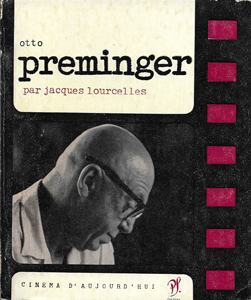 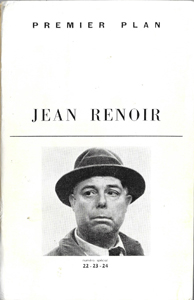 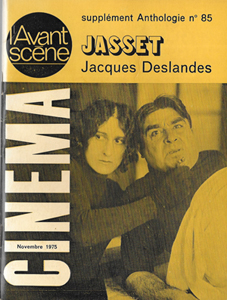
Three other French publishers provided more mixed models. The Seghers “Cinéma d’Aujourd’hui” series of squat, square paperbacks in stiff cardboard covers was a vast accomplishment, starting with Georges Sadoul’s 1961 book on Méliès. In a Seghers book, a critic’s long essay was followed by extracts from the filmmaker’s writings, snippets of reviews and critical commentary, and a fairly detailed filmography and bibliography. Because a substantial essay anchored a Seghers installment, it had some of the focus of a through-written critique.
“Premier Plan,” another series, came from Lyon, under the auspices of SERDOC (Société d’Études, de Rechereches, et de Documentation Cinématographique). Premier Plan books were usually flimsier than the Seghers ones. Some were simply filmographies with clip-quotes from reviews, but some, like the plump volume on Renoir, provided a substantial compilation of rare documents. Other entries featured long-form texts by experts like Barthélémy Amengual.
Yet a third series came into existence about the same time. The small-format entries in Anthologie du cinéma were published by L’Avant-scène, a company issuing texts of plays on a bimonthly basis. In 1961 it began publishing film scripts and transcripts as well. The first mini-monograph, Luda and Jean Schnitzler’s 1965 study of Dovzhenko, led to a great many dossiers, some on quite obscure figures.
All three series attracted some of the best critics and researchers. The old guard–Georges Sadoul, Jean Mitry, René Jeanne, Charles Ford–were balanced by the likes of Noël Burch, who wrote a provocative Seghers volume on Marcel L’Herbier, and Francis Lacassin, who contributed titles to both Seghers and Anthologie du cinéma. The 60s and early 70s were the boom years, when cinéphiles like me haunted the Gotham Book Mart, the Larry Edmunds Bookshop, and other specialty niches looking for that rare item on Anthony Mann or Vittorio Cottafavi.
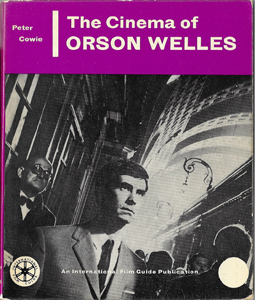 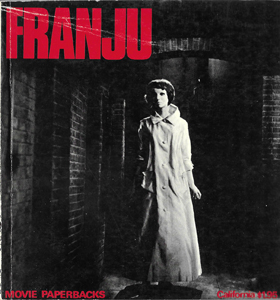 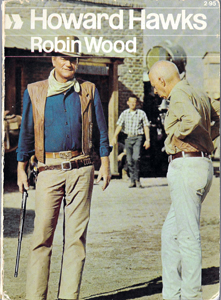
In England, a new generation of critics caught the auteur wave. Peter Cowie modeled his International Film Guide series on the Seghers format, launching it with his monograph Antonioni–Bergman–Resnais in 1963 and following it up with his book on Welles and Robin Wood’s trailblazing Hitchcock’s Films (both 1965). Published by the Tantivy Press and distributed by the distinguished art-book publisher Zwemmer, these were in-depth critical studies. Cowie’s series was pluralistic, focusing not only on directors but on genres and periods. Eventually the series would run to dozens of titles, along with the indispensable International Film Guide, an annual begun in 1963, and a journal, Focus on Film (1970-1977).
A parallel enterprise was launched by the critics around the important British auteur journal Movie (1962-). Its bold pictorial design, the creation of Ian Cameron, carried over to “Movie Paperbacks,” which launched in 1966. The books published major monographs by Robin Wood, Charles Barr, Raymond Durgnat, Michael Walker, and Cameron and his wife Elisabeth. Many were single-authored, but there were as well important anthologies on Godard and others.
Cinema One, published by Secker and Warburg, was linked to the British Film Institute’s magazine Sight and Sound. Beginning in 1967 with Richard Roud’s book on Godard, that series followed the model of the Movie paperbacks in integrating stills and texts. Cinema One books were either through-composed monographs, like Geoffrey Nowell-Smith’s entry on Visconti (1967), or interview books like the vastly influential Sirk on Sirk (1972).
Probably the highest-impact entry of the Cinema World series wasn’t a director study. Peter Wollen’s Signs and Meaning in the Cinema (1969) introduced a generation to semiology. Such was the sway of auteurism, though, that in one chapter Wollen tried to revamp that critical approach with a structuralist analysis comparing binary themes in John Ford and Howard Hawks.
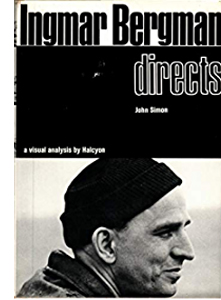 The 1960s saw an outpouring of auteur studies, along with many other books on film subjects. Because of the much bigger US market, the English series found copublishers and distributors stateside: Tantivy worked with A. S. Barnes, Movie with the University of California Press, and Cinema One with various commercial houses. Needless to say, the possibility of buying these books in local bookstores added joy to my college years. I remember getting Wood’s book on Hawks in Albany in 1968 and reading it immediately. Having already read his book on Hitchcock, I thought, Now we’re getting somewhere. The 1960s saw an outpouring of auteur studies, along with many other books on film subjects. Because of the much bigger US market, the English series found copublishers and distributors stateside: Tantivy worked with A. S. Barnes, Movie with the University of California Press, and Cinema One with various commercial houses. Needless to say, the possibility of buying these books in local bookstores added joy to my college years. I remember getting Wood’s book on Hawks in Albany in 1968 and reading it immediately. Having already read his book on Hitchcock, I thought, Now we’re getting somewhere.
The illustrations in these books tended to be production stills, photos taken on the set during filming. Frame enlargements from the finished film were difficult to obtain, and their quality was questionable. But one American publisher incorporated actual shots from the movie. Under the mysterious imprint “a visual analysis by Halcyon,” Harcourt Brace Jovanovich produced Alexander Walker’s Stanley Kubrick Directs (1971) and John Simon’s Ingmar Bergman Directs (1972) with specific frames enhancing the critics’ interpretations. The quality of the images wasn’t always good (sometimes subtitles were left in), and one can imagine editors pointing to the results as proof that production stills were preferable.
These Halcyon books seem to have had little impact on other publishers, but both showed that heavily illustrated in-depth commentary on an auteur’s work was feasible for a book-length study. Simon’s close reading of Persona remains a remarkable accomplishment, as fine-grained a piece of interpretation as we can find anywhere at the time.
M. Hulot, boxed
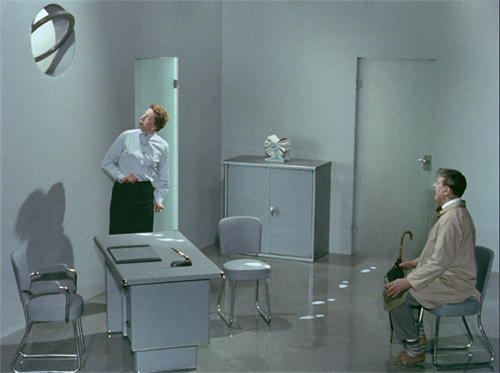
Mon Oncle (1958).
None of these books boasted big production values. The only de luxe auteur book of this period I can recall, and probably the prototoype of our Massive projects, was Donald Richie’s gorgeous The Films of Akira Kurosawa (1965). Published by the University of California Press but printed in Japan, it boasted excellent paper stock and authoritative critical interpretation, with Richie drawing on his unique access to personal conversations with Kurosawa. He displayed far more attention to style than most critics of his day, devoting sections of every chapter to cutting and camerawork. Arguably, the handsome interview book Truffaut/Hitchcock (1966) also paved the way for the large-scale auteur study. A little later, in a more obsessive vein, there was Robert Benayoun’s handsome oversize tribute to le fou Jerry, Bonjour, M. Lewis! (1972).
From the 1970s on, more lavish auteur volumes began to appear. Since they were expensive to produce, they were often the result of institutional support, and they tended toward the dossier format.
As the festival circuit expanded, those events hosted retrospectives of periods, genres, national cinemas, and, inevitably, auteurs. So it wasn’t surprising that Venice produced a high-gloss 1980 volume on Mizoguchi, with critical essays, interviews, and a detailed filmography surveying the master’s works, including lost films. For decades thereafter festivals created collectible catalogues based on their screenings. Followers of Hong Kong film, for instance, are forever in the debt of that festival for its in-depth publications on major figures like King Hu.
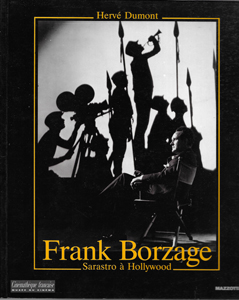 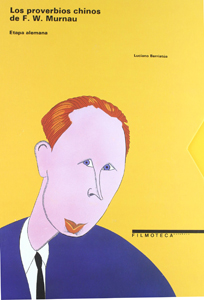 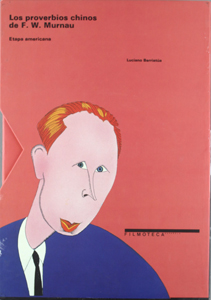
Similarly, just as museums published volumes commemorating major exhibitions, film archives began to finance catalogues derived from their programs. The books might be fairly modest, but some have been coffee-table quality. Usually these have been dossiers, but an important exception is Hervé Dumont’s monumental study Frank Borzage: Sarastro à Hollywood (La Cinémathèque francaise, 1993). The most stupendous dossier-catalogue I know comes from the Filmoteca Espagnola and bears the curious title, Los proverios chinos de F. W. Murnau. Edited by Luciano Berriatúa, this two-volume boxed set (weight: ten pounds) is a feast for the Murnau admirer. Its glossy pages teem with original sketches and plans, frame enlargements, and ancillary information about the films and the director’s life. Its key image, in two color schemes, is also refreshingly unpretentious.
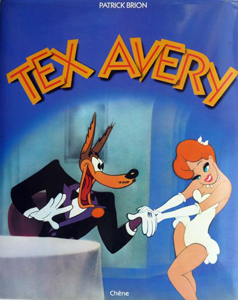 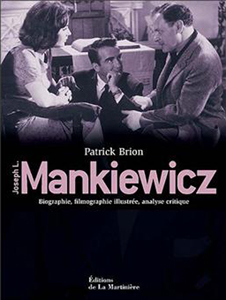 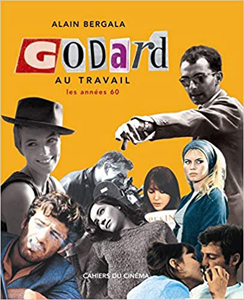
The French, as in other domains, have led the way with the deluxe auteur package. Patrick Brion, for instance, has written several large-scale studies. on animation and on directors like Joseph Mankiewicz (who’s much more deserving of a biopic than his brother, in my view). Cahiers‘ “au travail” albums, some translated into English, survey each director’s creative process by drawing on unpublished working documents.
From the 70s on, art-book publishers saw that there was a new audience among film fans and began to think of offering movie titles. There were quickie books, aimed for remainder markets and built out of publicity stills, but the prime player early on was Taschen, the firm long identified with distinctive books on the visual arts. Taschen, committed to producing books at all price ranges, released some inexpensive image-based movie titles, while also mounting unique limited editions of photography and painting. What else do you expect from a firm that offered as a bonus a stand to support a $25,000 book? (A baby version goes for just $1500.)
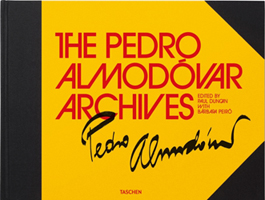 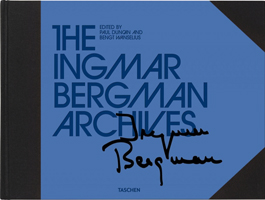 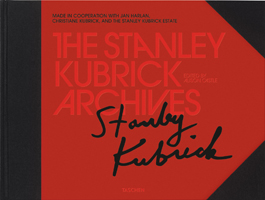
Taschen’s auteur campaign was part of its “Archives” series. Memorabilia and in-depth background from Star Wars, Disney cartoons, and the Bond films. were packed into huge horizontal-format volumes. In the same uniform design and binding came entries devoted to Almodóvar, Bergman, and Kubrick. It’s hard to know how to handle them for casual reading, but I suggest you supply your own table. The Kubrick volume was republished as a thick but more manageable volume; the paving stone became a brick.
But maybe the Archive releases aren’t really designed for normal reading. Like a gallery installation, they are easier to browse than to scrutinize. These books contain valuable primary documents, but a researcher into the subject would still yearn to see all those items that were kept back. One page of a script is interesting, but the scholar wants to see the whole thing. The Taschen volumes, impressive as they are, are high-grade fan compilations. They are stuffed yet tantalizing dossiers doing duty for an entire career: not so much an archive as an exhibition.
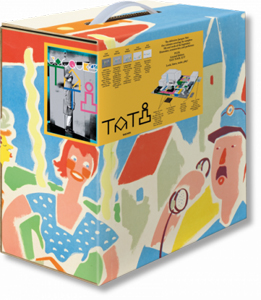
This year Taschen released an item that breaks with the design of the Archives line. The Definitive Jacques Tati, edited by Alison Castle, is is a five-volume boxed set. This homage to one of our most sprightly directors weighs nearly eighteen pounds, but the vaguely Bauhausian font and school-lunchbox packaging aim to lighten the tone. Volume 1, Tati Shoots, consists of production stills of scenes, each one given a separate page, as if it were a painting. Tati Writes offers scripts, reproduced complete (Jour de fête) or in extract pages, with English translations of the entire texts. Two unmade films, The Illusionist and Confusion, are included.
Tati claimed to have shot a film without looking at the script: “I know the film by heart.” The earliest screenplays in the volume are fairly minimal, but when we get to PlayTime, one of the most strenuously dense films of all time, the description of a single shot’s action can run to hundreds of words. The Royal Garden sequence, an hour-long tour de force, was planned in daunting detail, notating gestures, eye movements, and even the virtuoso matches on action.
The screenplay of this sequence is often packed with many more gags and bits of business than are onscreen in the versions we have. For instance, one of my favorite gags takes place when the air conditioning is switched on and we see the skin on a woman’s back ripple. Soon the fan is adjusted and her flesh settles down.
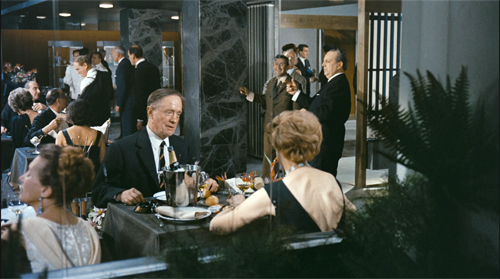 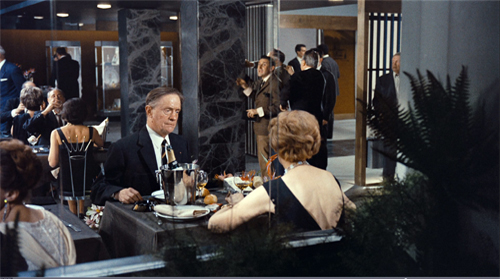
Apart from its sheer audacity (who thinks of a gag like this?), it comments on the flabby patronage of the restaurant. It also recalls the puffy plastic chairs that earlier bewilder Hulot by erasing his presence.
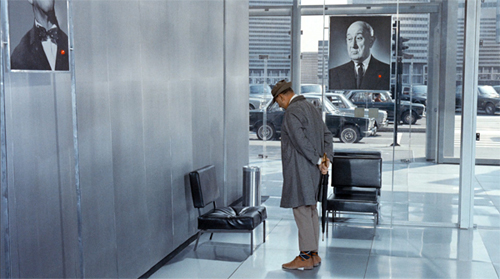 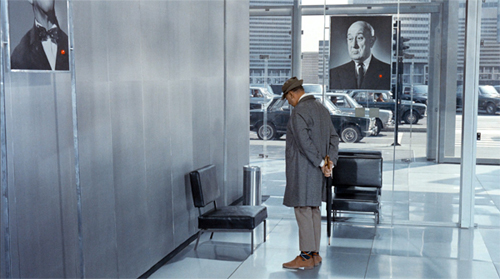
The AC gag is more elaborate in the screenplay; a technician fiddles with the controls, making the undulations vary until the adjustment is right. I don’t find an account of the provenance of the published PlayTime text , but if this is something like a late shooting script, Tati made enormous alterations, usually simplifications, during filming.
Volume 3, Tati Works consists of a biographical chronology and illustrated with family photos, followed by segments devoted to phases of his career, also heavily illustrated. It’s here that we get behind-the-scenes images of Tati at work. There are appreciative essays on the films, filling in background on the production and reception of the films while pointing up some of Tati’s artistic strategies. The writers acquaint readers with the core ideas of Tati criticism: comedy of observation, comments on modern life, deep and decentered composition, ricochet gags, anomalous sound effects. Most of these essays are by Jonathan Rosenbaum, who worked with Tati, while Jacques Kermabon and Alexandrine Dhainaut contribute background on the early films and the unfilmed projects respectively. Quotations from collaborators round out the volume.
Tati Explores consists of essays on recurring images (vehicles, architecture) and auditory strategies, by a range of French critics. These and the earlier essays are fairly brief and synoptic, in keeping with the general policy of favoring pictures over texts. Still, in volume 4 in particular, documents drawn from the archives often illuminate Tati’s creative process. We can see how the Mon Oncle gag with the spiny foliage was obsessively elaborated in advance.
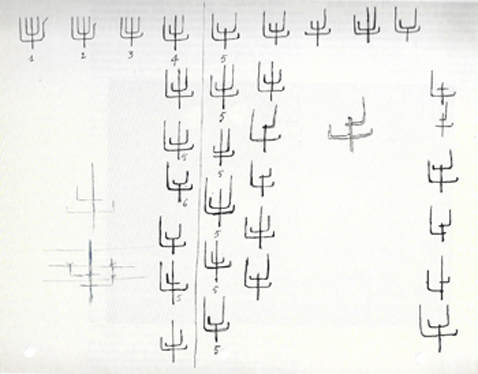 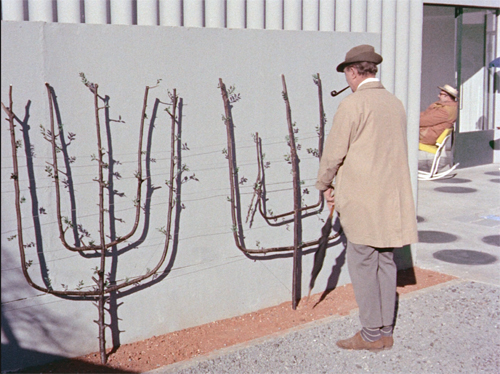
All this personal material made me think that perhaps we should go beyond treating Tati as an isolated artist, as if the local or global film industry had no impact on him, or him on it. His international standing as both filmmaker and performer was made possible partly by his brilliance as a mime, partly by his charmingly eccentric persona, and partly by subjects and themes that were widely intelligible. It seems to me that his easily grasped satiric targets (old versus new, country versus city, people trapped in routine, overweening technology) enabled him to make formally and stylistically complex movies. He smuggled innovative narrative and style in on the back of clichéd material.
In other words: We can always ask new questions.
The final volume, Tati Speaks, includes more on-set images, along with quotations from interviews. Again, pictures dominate, but there are some longish interviews at the end that allow Tati and his questioners to develop real conversations.
In all, The Definitive Jacques Tati is a kind of ultimate dossier collection, an act of homage that also aims to be a precious object in its own right. You can, up to a point, fondle these bulky volumes. For more hands-on engagement, you can upgrade to a numbered limited edition that includes a miniature set you can assemble yourself. Price $895 until 31 January 2021, thereafter $1000.
Immersed in Wesworld
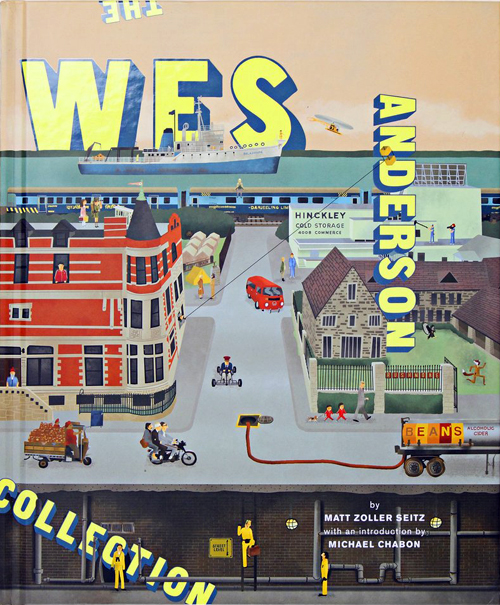
The whimsicality of the Tati box’s design, so different from the solemn slabs of Taschen’s Archive series, is in keeping with a new direction in the Massive Auteur Monograph. That tendency emerges most vigorously at another publisher, Abrams. Abrams had already embraced film animation as an art form, producing Helen McCarthy’s beautiful volume on Osamu Tezuka.
The new auteur bent is especially evident with Matt Zoller Seitz’s The Wes Anderson Collection (2013). It looks like a dossier, but actually I’d argue it’s an unusual critical monograph. Organized chronologically, film by film, it’s called by Seitz “a book-length conversation interspersed with critical essays, photos, and artwork.” As with the Taschen Archives, Seitz’s access to the filmmaker allows him to include working notes and sketches, storyboards and tests.
Ins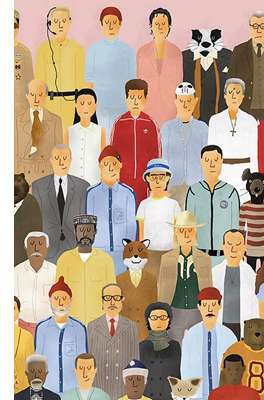 tead of a linear argument, Seitz offers a collage on interwoven themes in and around Anderson’s work, particularly his appetite for both high and low culture. Seitz’s free-range imagination comes up with influences and sources not obvious to an outsider. Who else picked up on Anderson’s debt to Peanuts and Star Wars? And Seitz can discuss these possibilities with the director. The sense of a running dialogue spills over every page, where the captions continue to make connections and send you flipping to other pages. These are a fan’s notes on a Borgesian scale, the print equivalent of hyperlinks. tead of a linear argument, Seitz offers a collage on interwoven themes in and around Anderson’s work, particularly his appetite for both high and low culture. Seitz’s free-range imagination comes up with influences and sources not obvious to an outsider. Who else picked up on Anderson’s debt to Peanuts and Star Wars? And Seitz can discuss these possibilities with the director. The sense of a running dialogue spills over every page, where the captions continue to make connections and send you flipping to other pages. These are a fan’s notes on a Borgesian scale, the print equivalent of hyperlinks.
The biggest breakthrough comes, I think, with a design decision. Instead of through-composing a critical argument, weaving interview quotes and claims about influences into seamless prose, Seitz decided to soak the whole package in Anderson-ness. The slightly tense nerdery, the OCD fixation on lists and details, the deadpan naïveté of the films–all are replicated in the very texture of the book.
Anderson’s vision, which creates childhood worlds filled with adult anxieties, is rendered in a sort of tween book for grownups. Each section is given an absurdly precise annotation (“”The 1,113-Word essay,” “The 7,065-Word Interview”). Each Anderson film invites us into a densely furnished milieu, and the book eagerly assists his near-maniacal worldbuilding. Bonus material includes logos and indicia from the fictional companies, organizations, and texts. Reproducing the yearbook montage from Rushmore, Seitz supplies “activity cards” drawn from shots from the film. A pastiche ad for The Dollar Book Club (in Garden City, of course) offers for a mere $1 the library books Suzy has swiped in Moonrise Kingdom.
Seitz’s artwork includes color drawings by Max Dalton that reinterpret the inhabitants of Wesworld as wispy cutouts, arms hanging down, as if in a police lineup or a paper-doll sheet. Often with their eyes lowered, they have the awkwardness of exceptionally intelligent people who haven’t yet figured out “self-presentation” and “impression management.” Under Dalton’s hand, a landscape becomes an urbane New Yorker rendering of Grandma Moses.
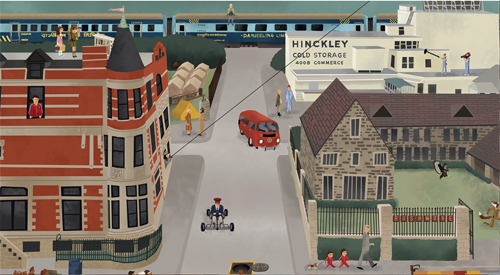
The real tipoff, I think, comes with the end papers, which consist of a vast grid of characters as imagined by Dalton. This is a book Anderson characters would like to own: geek chic.
Unsympathetic critics who find the films over-cute (I’m trying to avoid the label “twee”) will find this a double dose of it. I, who like the films, find it a fascinating step forward in rethinking what the auteur monograph could be. The sequels devoted to The Grand Budapest Hotel and Isle of Dogs embrace the dossier format, incorporating essays and interviews from others. But the presentational mold was set: each one is a piece of bespoke Andersoniana. Seitz went on to apply the same principle to a very different director, Oliver Stone, and he gave that Abrams book an appropriately tense, smashmouth aesthetic. Interviews are scoured by redactions, illustrations are psychedelic jumbles.
Auteurism on steroids
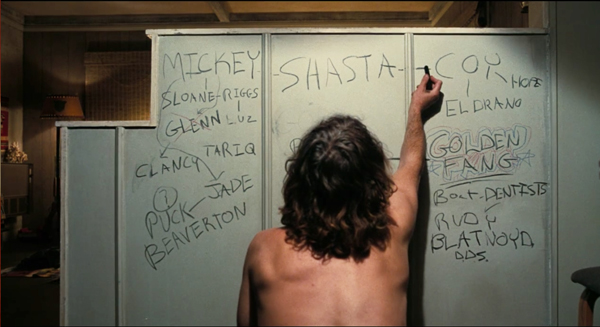
Inherent Vice (2014).
Most recently, Abrams has given us two Massive Auteur Monographs, written by Cinema Scope and Little White Lies critic Adam Nayman. Considering them alongside the Seitz books, we can spell out some conventions of the new model–some inherited from classic auteurism, some in the process of emerging.
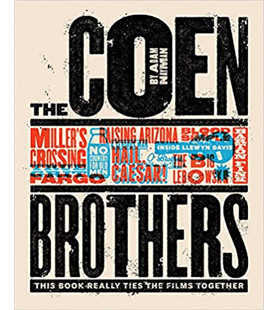 *Deep-dyed Auteurism. The title The Coen Brothers: This Book Really Ties the Films Together (2018) says it all. The director(s) has (have) a unified but nuanced vision, the critic will reveal it, and aficionados will understand the subtitle as both an homage and a meta-reflection on auteurism itself. The Coens have a “comic universe” of rich interconnections. In the same vein, Nayman’s Paul Thomas Anderson Masterworks (2020) cautiously acknowledges Anderson as bearer of “a heroic–indeed, mythic auteurism, bridging past and present, personal and populist.” In an age of blockbusters, “ambitious, challenging American films” will always demand “auteurist approbation.” The critic can uncover the inputs of collaborators and draw out their ideas in interviews, but the director remains at the center: at least a synthesizer, and at most a demiurge transforming everything into something personal. *Deep-dyed Auteurism. The title The Coen Brothers: This Book Really Ties the Films Together (2018) says it all. The director(s) has (have) a unified but nuanced vision, the critic will reveal it, and aficionados will understand the subtitle as both an homage and a meta-reflection on auteurism itself. The Coens have a “comic universe” of rich interconnections. In the same vein, Nayman’s Paul Thomas Anderson Masterworks (2020) cautiously acknowledges Anderson as bearer of “a heroic–indeed, mythic auteurism, bridging past and present, personal and populist.” In an age of blockbusters, “ambitious, challenging American films” will always demand “auteurist approbation.” The critic can uncover the inputs of collaborators and draw out their ideas in interviews, but the director remains at the center: at least a synthesizer, and at most a demiurge transforming everything into something personal.
*A Criticism of enthusiasm. It was a tenet of Cahiers du cinéma that the best reviewer of a film was the critic who most liked it. To critics of a judicial bent, that looked like defection from the role of stern magistrate, but the idea was that the best possible case for a film would be made by an admirer. Nayman is unabashed. Phantom Thread is “a surpassingly funny movie,” Raising Arizona is “fully endearing,” Magnolia is “something to behold.” Enthusiasm doesn’t equal blind worship. Nayman doesn’t find the films flawless. He also grants his changing estimation of Anderson’s career as it developed. Still, these are judgments made within a broader attitude of passionate support.
Arguably, shortcomings are minimized by a Massive book’s sheer footprint. Enthusiasm can come through in a short piece or a small, square book, but The Coen Brothers and Paul Thomas Anderson Masterworks fill about 300 large-format pages apiece and weigh between three and four pounds. Size matters. When packed into the howitzer dimensions of a coffee-table book, the case for the value of the director is strengthened by sheer avoirdupois.
*Personality plus. Andrew Sarris posited “the distinguishable personality of the director” as a central criterion of value for the auteur critic. He didn’t distinguish between the personality of the actual flesh-and-blood filmmaker and the “personality” projected in the work. Modern critics are more careful, but there’s still an impulse to study the works in light of everything we can know about the artist’s life, influences, and obsessions. Hence critics’ continual pursuit of how the private lives of Hitchcock, Welles, and other directors inform their work.
The concentration on the director’s personality led many skeptics to consider auteur criticism as a throwback to Romantic aesthetics, where the all-powerful poet infuses deep feelings and formative experiences into the art work. Part of Wollen’s heresy in Signs and Meaning was to sever the films from the living creators.
Like Seitz, and indeed like most auteurists since the 1960s, Nayman is sensitive to the director’s transformation of prior material. He will study how an adaptation reweights the original, as when There Will Be Blood trims political contexts from Sinclair’s Oil! More important, he will probe the more tenuous inspirations working under the surface of the finished film. We can’t recover many of those subterranean currents from the days of Hawks or Mizoguchi, but focusing on living filmmakers gives these monographs an advantage. Authors can question the director (Seitz) or track down interviews (Nayman) that bring out a hidden network of intimate inspirations. Seitz discloses Rushmore’s debt to Peanuts, and Nayman links Inherent Vice to the Fabulous Furry Freak Brothers–and Leonardo’s Last Supper.
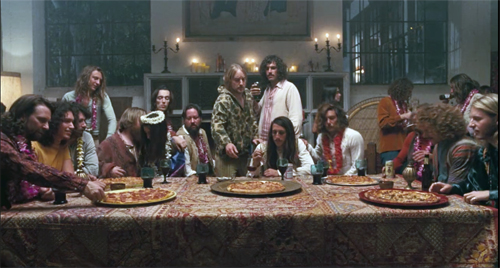
The personality factor gets magnified in the age of the Massive Auteur Monograph. The scale of the enterprise lifts the film director to the level of a gallery artist, putting idiosyncrasy on display. Moreover, whereas old-style auteurists could signal debts to Pirandello or Picasso by passing references in prose, the big-ass Auteur book can spread out a bounty of iconography: paintings, snapshots, album covers, comics, and virtually anything else. For the Coens we get a cartoon illustration of books that influenced them; for Anderson, there’s an interpolated series, “PTA’s Movie Collection.” This almost philological archaeology is part of the Massive project’s raison d’être.
*Something to say. When I told a friend that I thought Spielberg was an exceptionally skilful filmmaker, she agreed but added: “Too bad he has nothing to say.” An auteur is held to be an artist, not just an artisan, and an artist gives us something meaningful in and through the artwork. Guided by this premise, auteur criticism has traditionally been focused on thematic interpretation. How does the filmmaker’s personal angle of vision transform the thematic material?
Nayman acknowledges that critics have found a nest of themes typical of his subjects: male inadequacy in the Coens, father/son relationships in Anderson, and more. He develops these and others in his own interpretive commentary, and like Seitz, he has incorporated frame enlargements into his argument, so his claims gain specificity. Shots from Punch-Drunk Love counterpose a map and the abandoned harmonium as evidence for “the desire to travel” set aganst “a symbol of potential order that must be protected and mastered for the character to achieve self-actualization.”
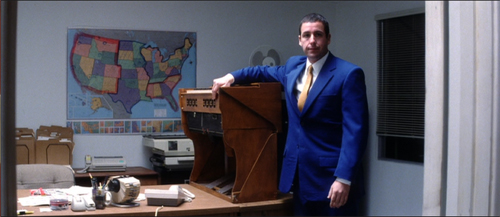
The Massive format allows critical commentary some new opportunities. Interpretive asides can be attached to sidebars or even the stills parked along the main text. Whereas your classic picture book has a neutral caption, the captions in the Abrams books tend to make critical points by hooking the picture to the text or other illustrations. In addition, the urge to fill out the format allows the critic to expand the interpretation through bonus materials. The tabletop landscapes of Wesworld created by Dalton find their counterparts in Nayman’s books in original illustrations that offer artists’ interpretations of the story worlds. In this illustration for There Will Be Blood, George Wylesol provides glimpses of motifs recognizable only if you’ve seen the film.
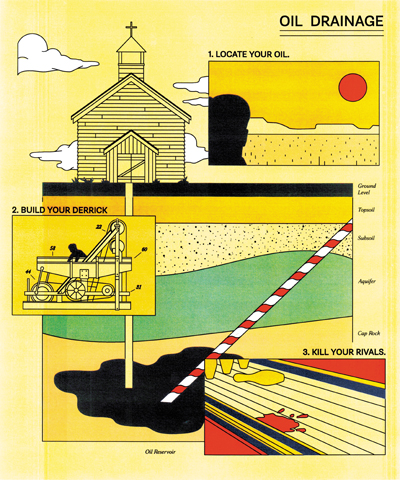
The movie opens up. Classic auteurism tended toward traditional notions of “variety in unity.” Robin Wood’s Hawks monograph, for instance, is a rigorous argument for a few recurring themes and variations in the director’s most characteristic work. But the sheer expanse of a Massive project–swallowing up all the films, even ephemera like shorts and uncompleted projects–and the search for the most remote and tenous links to books, cultural events, other films, and almost anything else, work against a more austere delineation of the artist’s achievement.
The risk is that the critic’s argument is overshadowed by the bonus materials, the way the vast making-of supplements to The Lord of the Rings DVDs vie for attention with the movie itself. At best, though, the ancillaries pry the film open. The books are large, they contain multitudes, and so do the films. Like a webpage bristling with links and pop-ups, the books invite you to see the films stretching tentacles out in all directions.
*Criticism as creation. However humbly the auteurist approaches the director, criticism remains partly a performance. If the filmmakers stand out as personalities, so too does a critic. Seitz, for instance, emerges from his books as a voracious, encyclopedically knowledgeable pop-culture maven. Nayman strikes a more academic tone, invoking in one page Freud’s oceanic feeling, the idea of structuring absence, and signifiers. Again, from the sixties auteur criticism always straddled belletristic writing (call it haute journalism) and academic studies. (Scads of university press books have taken the auteur line.) Nayman, like many ambitious critics, draws on academic ideas pointillistically, subordinating them to the tasks of appreciation.
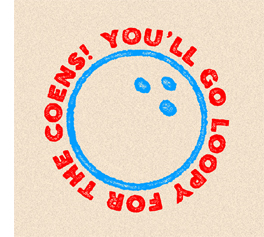 But we’d be selling these books short if we didn’t acknowledge their efforts to treat criticism as a striking creative act in its own right. Nayman revises some norms, as when he foregoes film-by-film chronology in the Anderson volume. More radically, from the full-page cartoons and original illustrations to the bespoke endpapers and the marginal curlicues (tumbleweeds in The Coens, doodles in Anderson Masterworks), the books aim to become supplements to the artist’s achievement. No surface is spared from Auteurist High Concept, as when the back cover of The Coens invokes not only The Big Lebowski but Nayman’s argument that the films play out circular patterns. But we’d be selling these books short if we didn’t acknowledge their efforts to treat criticism as a striking creative act in its own right. Nayman revises some norms, as when he foregoes film-by-film chronology in the Anderson volume. More radically, from the full-page cartoons and original illustrations to the bespoke endpapers and the marginal curlicues (tumbleweeds in The Coens, doodles in Anderson Masterworks), the books aim to become supplements to the artist’s achievement. No surface is spared from Auteurist High Concept, as when the back cover of The Coens invokes not only The Big Lebowski but Nayman’s argument that the films play out circular patterns.
Through-composed to the max, each book proposes itself as an art object that, though coming after the fact, has as valid a tie to the oeuvre as the innumerable works that influenced the makers. One venerable publishing tradition, to which both Taschen and Abrams belong, is committed to creating artworks about artworks.
Auteurism can be fun. All this intertextuality might have been solemn in the manner of literary criticism, but it turns out to be almost giddily playful. Tati, the Coens, and Wes Anderson invite a light touch, and more serious auteurs like Stone and Paul Thomas Anderson have their wild sides that can be celebrated in unpretentious new illustrations. With their echoes of books you flopped on the floor and read on your tummy, these publications offer a surprise every time you turn the page. This appeal to the kid in us, always bracketed by our knowledge that we’re deliberately indulging ourselves, gives auteurism something that millennials might latch onto. It carries a bit of that hip knowingness that Thomas Frank in The Conquest of Cool has described as the dominant way many of us consume popular culture.
That knowingness, steeped in authentic love, is central to fandom. Auteurists have always had a fannish streak. If we are all nerds now, then we can see the Massive Auteur Monograph’s emergence as owing something to what’s been called the “fan-favorite” publishing genre. The parallel is obvious: Wes Anderson fans aren’t as numerous as Star Wars fans, but they’re no less devout. (Some proof is here.) With suitable adjustments, the production values of books like The Transformers Vault (2010) could be transferred to The Wes Anderson Collection. Abrams Executive Editor Eric Klopfer explains that some filmmakers, themselves fans, are receptive to such projects. “These types of books are very close to their heart,” Klopfer says. “Many of them were influenced by these books as they were coming up.”
Books like Seitz’s and Nayman’s may make old-guard cinephiles rethink what film criticism can be, and they may introduce young people to auteurism itself. If these books came out when I was fifteen, I’d probably think they were the coolest things I’d ever seen.
Absorbing the lessons of the MAM
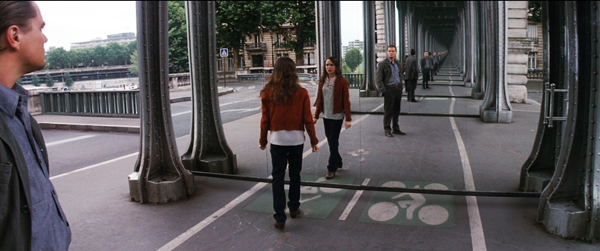
Inception (2010).
In various ways, then, these books are redefining critical writing. We should expect more Massive Auteur Monographs; the next Wes Anderson one has already been announced. But we can see their influence in less obvious ways, and I think Tom Shone’s new book on Christopher Nolan suggests some other intriguing options.
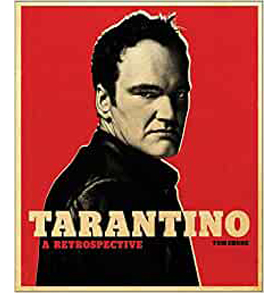 Shone has written one of the best books on post-1970s Hollywood (Blockbuster: How Hollywood Learned to Stop Worrying and Love the Summer, 2004), and a Massive Auteur Monograph (Tarantino: A Retrospective, 2017). His newest project, The Nolan Variations: The Movies, Mysteries, and Marvels of Christopher Nolan, seems at first glance a more traditional effort. Although it’s heavy-duty (2.6 pounds), it doesn’t need a big form factor. In Nolan’s case, the mission of fan pageantry has already been accomplished by James Mottram’s informative and picture-plentiful behind-the-scenes books, authorized by the director. Shone has written one of the best books on post-1970s Hollywood (Blockbuster: How Hollywood Learned to Stop Worrying and Love the Summer, 2004), and a Massive Auteur Monograph (Tarantino: A Retrospective, 2017). His newest project, The Nolan Variations: The Movies, Mysteries, and Marvels of Christopher Nolan, seems at first glance a more traditional effort. Although it’s heavy-duty (2.6 pounds), it doesn’t need a big form factor. In Nolan’s case, the mission of fan pageantry has already been accomplished by James Mottram’s informative and picture-plentiful behind-the-scenes books, authorized by the director.
Shone subscribes to most of the auteur conventions I’ve mentioned, although he’s somewhat more straightforwardly critical of certain films or moments. On the whole, this is a work of auteurist advocacy. Shone presents Nolan as both a craftsman interested in technical problems and a visionary director with a unique perspective on themes of time, identity, and history.
Shone moves chronologically from film to film by means of old-fashioned literary prose. He examines plot, character, visual style, and, in gratifying detail, music. He gives up the choppiness of the dossiers and the centrifugal pressures of the Abrams model. There are no sidebars and little effort to identify the physical book as an extension of the films. Frame enlargements, along with extrinsic visual evidence like storyboards and posters for influential films, are subordinate to the ongoing argument. So are the captions, which aren’t as chatty as we tend to get in the Abrams books. This is a book demanding one-track reading.
Yet it doesn’t sacrifice the intimacy and detail of the Massive ones. Part of its originality lies in the effort to enhance the idea of authorial personality through traditional biographical criticism. Shone suggests that Nolan’s concern with pattern has roots in his youth, particularly his years growing up in a highly regimented boarding school. Shone also provides an intellectual history of Nolan’s philosophical concerns. Kant shows up in the fifth paragraph, and soon enough we encounter Helmholtz and Penrose–names you don’t expect to meet in books about the Coens.
This isn’t showboating. Shone argues that these thinkers shaped Nolan’s art as decisively as did Chariots of Fire and Pulp Fiction. Nolan’s artistry draws from high culture as well as middlebrow and popular sources. Shone traces how philosophical ideas surface in the form and style of the films, from the play with time to Nolan’s concern with the Shepard tone as a model for both music and narrative organization.
Apart from tracing how the films are shaped by Nolan’s reading and thinking, Shone absorbs another level of discourse into his account. He met Nolan on several occasions after 1999. Instead of separating out chunks of their conversation as inserted interviews à la Seitz, he weaves their ongoing discussions into his film-by-film discussion. This gives the book an almost novelistic structure, which traces as a subtheme the progress of the two men’s dialogue.
Early on, Shone does detective work on Nolan’s personal history and proposes some interpretations that Nolan hesitates to grant. (“I was always very resistant to the notion of biography as it applies to criticism.”) Their encounters engender a degree of novelistic suspense when early on Nolan proposes a challenge: In words only, over the telephone, explain the concept of left and right.
Shone’s efforts to solve the problem become a running motif and inject a sting of drama into the book’s final pages. The problem and a couple of solutions are left wobbling at the end, like the top in Inception. No need for a still and a caption: Shone has woven the films’ imagery and structure, his investigation of them, and his conversations with Nolan into such a tight fabric that the reader gets the point. The project becomes, in its final lines, as cryptically reflexive as Nolan’s own work.
Perhaps Shone would have thickened the traditional auteur study in these ways without the existence of the more extroverted Monographs. But I can’t help thinking that The Nolan Variations (itself a reflexive title, with the critic as keyboard performer) has quietly absorbed the lessons of the more flamboyantly virtuoso projects. If they’re like Ives symphonies, this is more Mahlerian. The breaks and discordances are less evident, but the range of ambition remains.
The Tati box aside, these books are generously priced. In an era when a forgettable novel costs about twenty bucks, these books are offered at $40 or less. (The tiny Movie monograph I bought for $1.95 in 1967 would cost over $23 in today’s currency.) And Taschen’s compact Kubrick edition, at $20, reasserts the firm’s willingness to reach a wide audience.
Even if these books weren’t bargains, I think we need to consider them an important development in film culture. Just as the 1960s critical studies responded to the New Waves and Young Cinemas of that period, with their cult of the director, we can see the Massive Auteur Monograph as reacting to a host of cultural forces. There’s the ongoing idea of the celebrity director. There’s the wide availability of classic films to be referenced by both filmmakers and writers. Now we have the ability to scrutinize films on video. There’s the constant demands that modern publishing discover niche audiences. More and more, distributors promote the prestige of the Creatives. And of course the Internet has accustomed people to treating reading as multitasking. The dispersed layout of some of these book pages is like a monitor with many screens open.
Directors like Wes Anderson, the Coens, Nolan, and Paul Thomas Anderson are recasting auteur cinema for our time–not least in their willingness to cooperate on Massive Monographs. And books like these, whether presented as a bristling montage (Seitz, Nayman) or as a spiral tethered to core concerns (Shone), seem to me to revise auteurist criticism from the inside. Which only reasserts the study of directors as an enduring critical perspective.
I should disclose that I’m friends with Matt Zoller Seitz, and I’ve contributed to his volumes on The Grand Budapest Hotel and The French Dispatch of the Liberty, Kansas Evening Sun.. I’ve become acquainted with Adam Nayman, Eric Klopfer, and Tom Shone through friendly email correspondence. Thanks to Adam and Eric for assistance with illustrations, and to Peter Cowie for background on Tantivy.
The “fondling” point is made by David Roberts in “The Changing Face of Publishing,” in Martin Edwards, ed., Howdunit:A Masterclass in Crime Writing by Members of the Detection Club (Collins, 2020), 401. The quotation from Andrew Sarris comes from The Primal Screen: Essays on Film and Related Subjects (Simon & Schuster, 1973), 50. I discuss Sarris’s account of auteurism in “Cinecerity,” Poetics of Cinema, Chapter 8, and in this blog entry.
For a fan-inflected but still carefully researched example of the Massive Monograph that’s devoted to a single film, see Jason Bailey, Pulp Fiction: The Complete Story of Quentin Tarantino’s Masterpiece (Voyageur, 2013). Interestingly, it came out the same year as Seitz’s first Wes Anderson book.
On Tati, for examples of in-depth analyses I’d recommend Malcolm Turvey’s monograph on Tati and comic modernism, or go back to Kristin’s pathbreaking studies of the 1970s and 1980s, reprinted in her Breaking the Glass Armor collection. We have considered Wes Anderson’s films in many blog entries. On Nolan our ideas are presented on this site and in revised form in our book on the director. I discuss some Coen directorial strategies in relation to a scene in The Ballad of Buster Scruggs. On Anderson’s Magnolia as a network narrative, you can check Chapter 7 of Poetics of Cinema.
My 1981 book on Carl Dreyer, which I modeled on Richie’s Kurosawa study, might seem to be a step toward the Massive Auteur Monograph. My 1988 Ozu book might also count. But these are more academic and less freewheeling than the recent developments I’ve considered.
Making Meaning: Inference and Rhetoric in the Interpretation of Cinema proposes an account of thematic criticism as a practice. A recent blog entry on the subject takes The Hunt as an example. If you want to dig deeper, go here.
P.S. Ever-alert reader and high-energy critic Adrian Martin has signaled to me a large-format series I didn’t know about. The Théâtres au cinéma books were published by the now-suspended festival of Bobigny, France. The series is another example of institutional investment in a festival permitting de luxe publishing. Adrian writes that the choice of auteurs includes
Bellocchio, Ruiz, Fassbinder, Jarman, Robert Kramer, Akerman, Parajanov, Rocha, etc. And they are part of a mixed “arts festival event,” nominally a “cinema/theatre” crossover, that combines film retrospectives, theatre and music events, art exhibitions, readings of unproduced screenplays, concerts, etc. . . . There is often remarkable archival work involved: Kramer’s hand-assembled collages, previously unpublished texts by directors, interviewers with collaborators never before sought out by researchers (including, for example, Bellocchio’s psychoanalyst and co-writer for a while!). Even the ‘snippets of criticism’ that fill out the vast filmographies are a great resource.
Adrian praises in particular editor Cyril Béghin for his careful research and the high quality of the critical material he included. Thanks to Adrian for the tip!
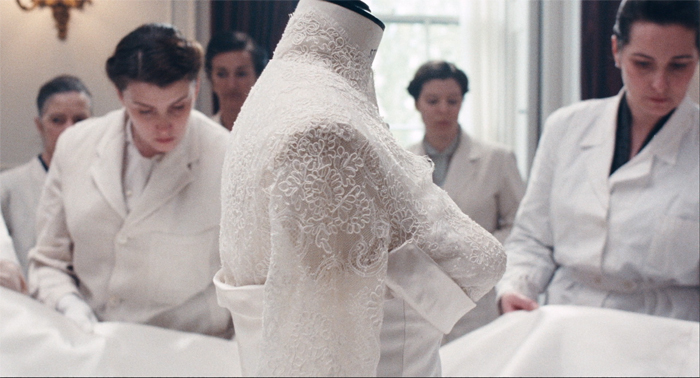
Phantom Thread (2017)
Posted in Books, Directors: Anderson, Paul Thomas, Directors: Anderson, Wes, Directors: Nolan, Directors: Tati |  open printable version
| Comments Off on Books worth fondling, if you can lift them: The rise of the Massive Auteur Monograph open printable version
| Comments Off on Books worth fondling, if you can lift them: The rise of the Massive Auteur Monograph
Wednesday | December 9, 2020
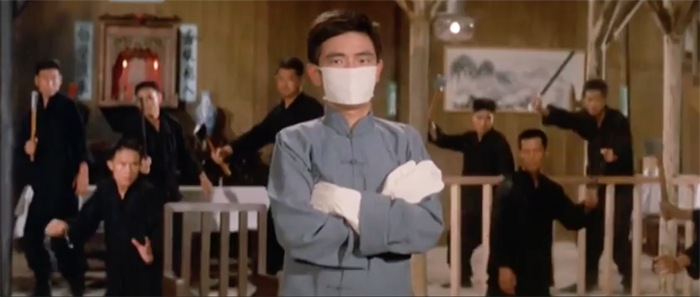
….why should we complain?
(Probably not for very young viewers.)
From The Chinese Boxer (龙虎斗, 1970).
Posted in Film comments, National cinemas: Hong Kong, People we like |  open printable version
| Comments Off on If Jimmy Wang Yu can wear a mask and do all this… open printable version
| Comments Off on If Jimmy Wang Yu can wear a mask and do all this…
|







































































































































